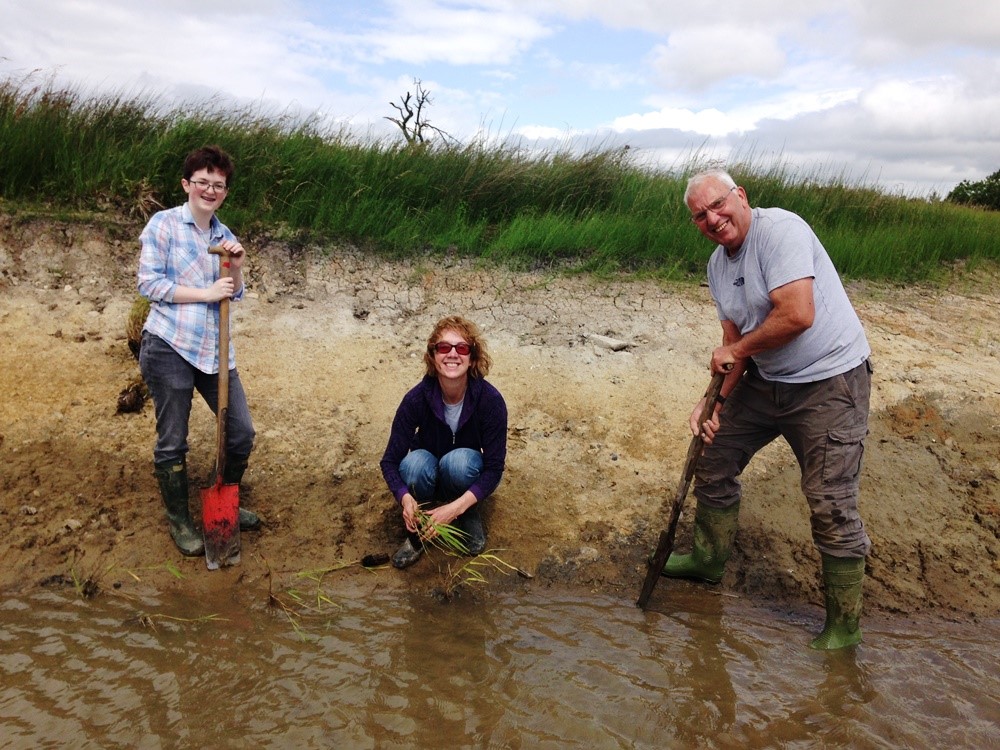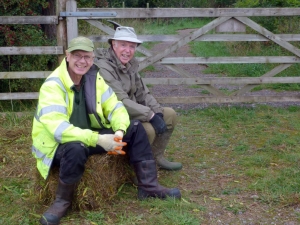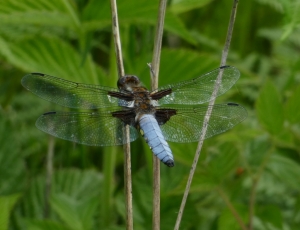Blog Archive (32) Posts Made in August 2018
What a load of Chaff
Friday, August 31st 2018
Today was a mixed bag as always, with the majority of our time spent sorting through newly delivered chaff, which is used to feed birds from the hoppers that are dotted around the Reserve.

Aside from chaff sorting we have been busy re-edging and preparing paths for relaying, as well as continuing to GIS map the many different elements that make up the Reserve.

Colin has been in as per usual and has filled up the bird feeders ready for Bird Ringing on Sunday (2nd), which will be the final instalment of the BTO Constant Effort Scheme for 2018. Colin has also been enjoying re-edging the front lawn as is evident from the picture below.
.jpg)
Top Orchard Hay Cut
Wednesday, August 29th 2018
Summer time cutting of our Mini Meadows is well under way at this point; today we have been cutting the Top Orchard, avoiding the many flowering plants and Orchids that are still yet to seed.


I've been helped by Ken and Linda today who have taken time out from Mothing and cutting back vegetation in order to help me rake up the cuttings from the Orchard. This acts to ensure that we reduce the fertility of the soil over time, which in turn reduces the more competitive grass species.

Despite all of the hard work there is still some raking left to do tomorrow, and further cutting do carry out on theTop Orchard after the wildflowers have gone to seed.
Raking and Burning
Tuesday, August 28th 2018
The Reserve Managers and Volunteers started the day by raking off what was cut from the bottom orchard yesterday.
It is likely that this area will need to be cut once more before the Autumn cut. At this time small areas of sod will be removed and sown with Hay Rattle so as to reduce the percentage of grass in the sward over the coming years, and to give wildflowers a chance to come through (FYI you can buy Hay Rattle seeds in the Field Centre Activity Room for £1 per sachet!).

After a short break work commenced on burning the brash that has built up at the Bullet Catcher over the Summer in preparation for the end of the bird nesting season, and the start of tree works on the Reserve.

There was plenty of time to admire the many Odonates at the Bullet Catcher Pond while waiting for the fire to die down!

Bottom Orchard Hay Cut
Monday, August 27th 2018
It's been a busy Bank Holiday Monday at Foxglove despite the changeable weather.
The Reserve Staff have been working on tidying up and cutting the bottom orchard.

Over the coming weeks we will be carrying out the main summer cut on all of our mini meadows, which will serve to remove the bulk of the material whilst favouring summer flowers such as knapweed, devil's bit scabious and lady's bedstraw.

You may have noticed from the after cut picture above that we have left some areas longer than others; these are areas rich in wildflowers that are yet to seed, such as fleabane, selfheal and ribwort plantain.
Dry and Wet
Sunday, August 26th 2018
Yesterday, although the wind had a definite bite to it, in the sunshine it was warm. A Common Blue butterfly was making the most of the warmth.
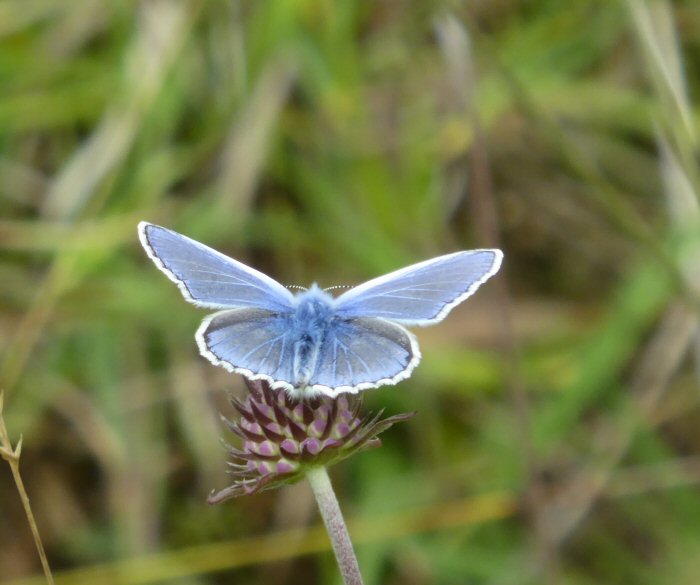
A second one was flitting around landing on flowers and grass. I followed it and when it landed took a photograph. On downloading the photo I found that there was a thistle seed behind the butterfly.
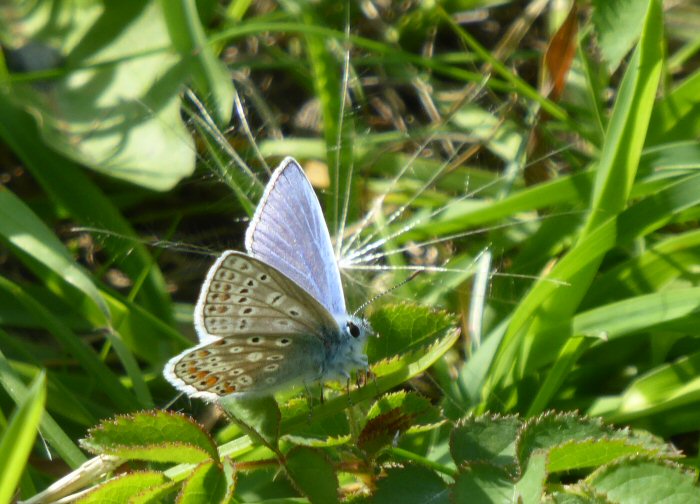
The weather was just a little different today, wet! Down on the lake it was quite quiet. A Tufted Duck was resting in front of the hide, when suddenly it shot upwards then flew across to the side of the lake. There was no movement around her at all. It set me wondering if something had nibbled her feet!
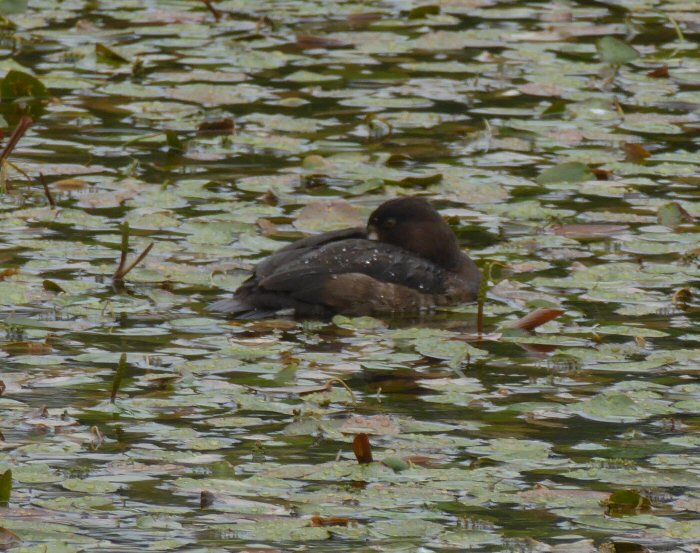
I watched as three Moorhens headed into the reeds. They jumped onto some of the stems of the reeds and bent them over, then sat on them and began to preen.
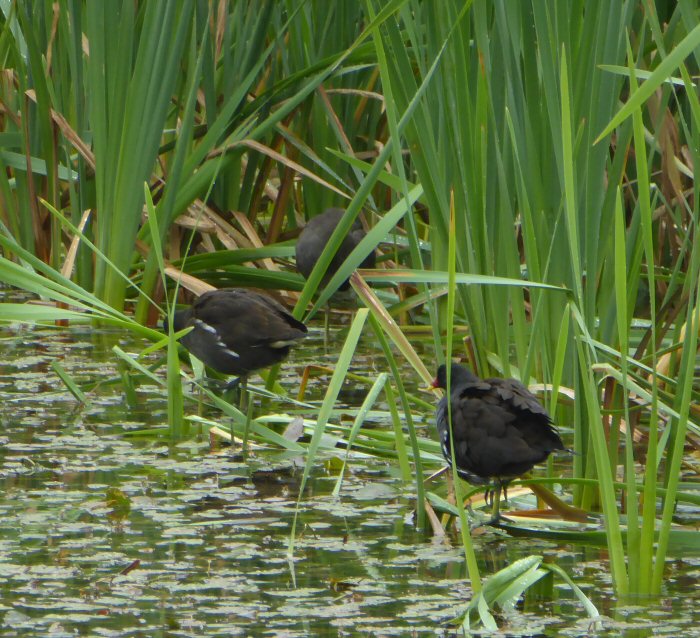
There was very little insect life moving. I found a spider sheltering under an Angelica flower but the photographs are not good enough for the blog. A bee was also trying to hide out of the rain on a Devil's Bit Scabious flower, which I had to bend over to take a photo. A leg was shaken at me as a warning! Once the photo was taken I gently moved it back to give the bee some peace.
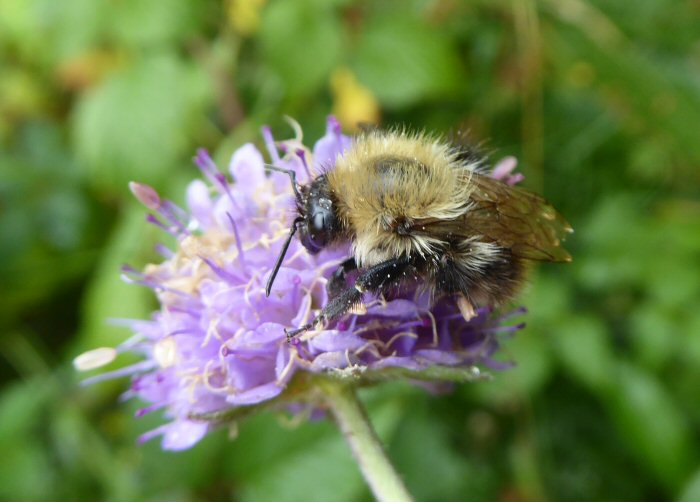
As it was raining there has to be some rain drops on the blog.
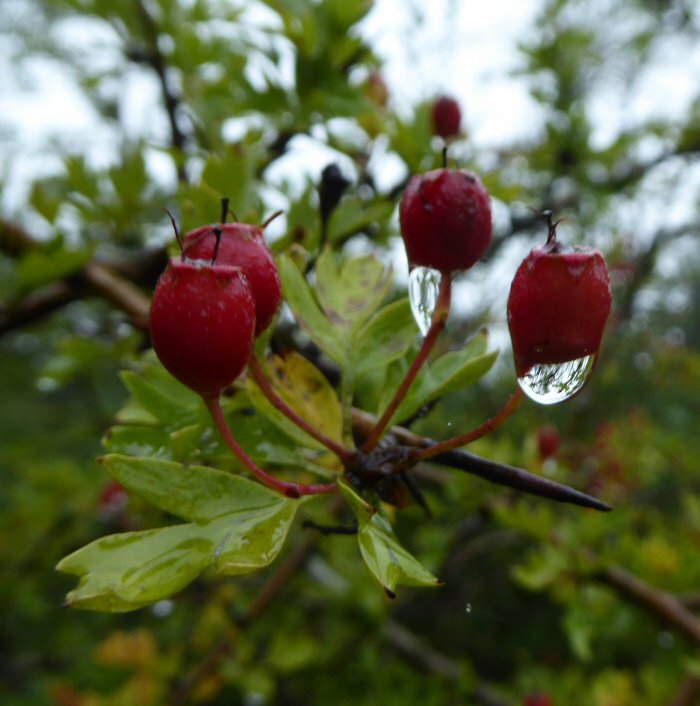
One More to Go
Saturday, August 25th 2018
It was CES 11 today so we only have one more to go to complete 26 years without missing a single visit. A tremendous achievement.
A cool and slightly more windy morning than expected greeted the bird ringers for a 0515 start. The Bullfinches were out in force and 25 new ones were ringed. They can breed late in the season and this one was obviously a late youngster as it was showing no signs of post juvenile moult.
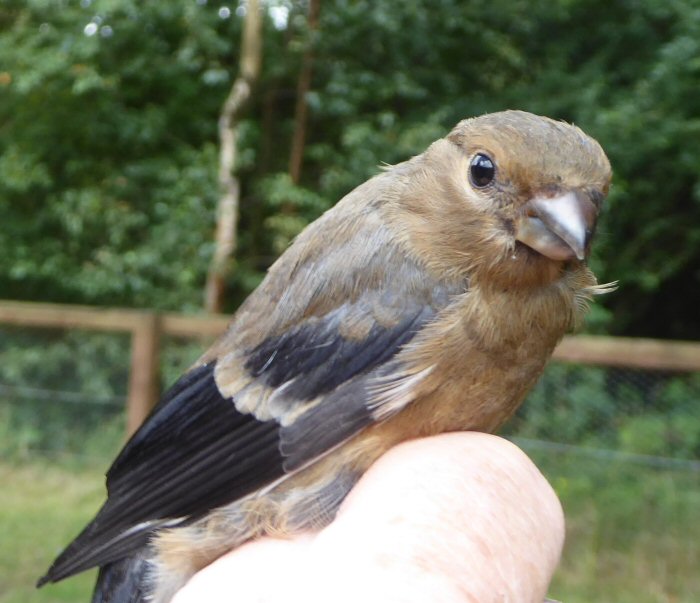
Some weeks ago on the blog there were photographs of juvenile Robins, showing how they changed from a speckled breast to just a few red feathers. Pupils from Wavell School were following the Robins. The photograph below shows one still moulting so it has a few wayward feathers. Its red breast is almost complete.
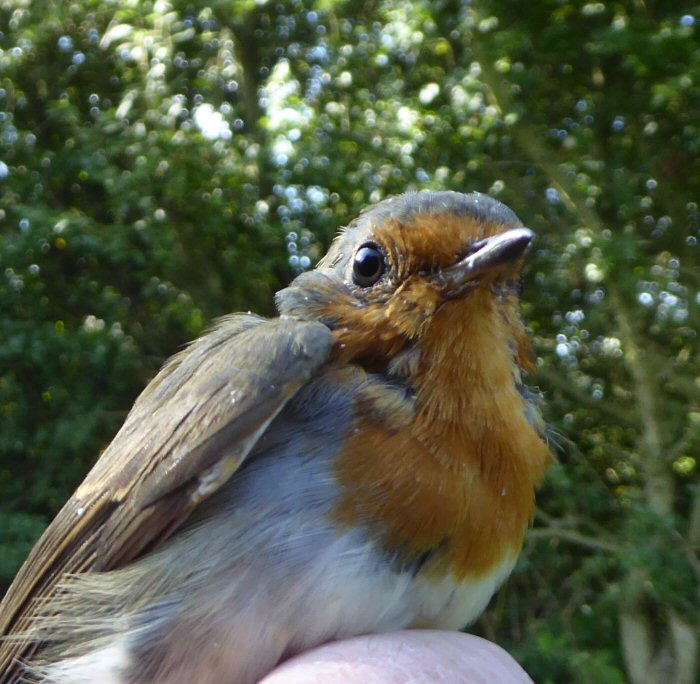
Later in the day a youngster arrived in the ringing room, having completed its moult and showing its pristine feathers.
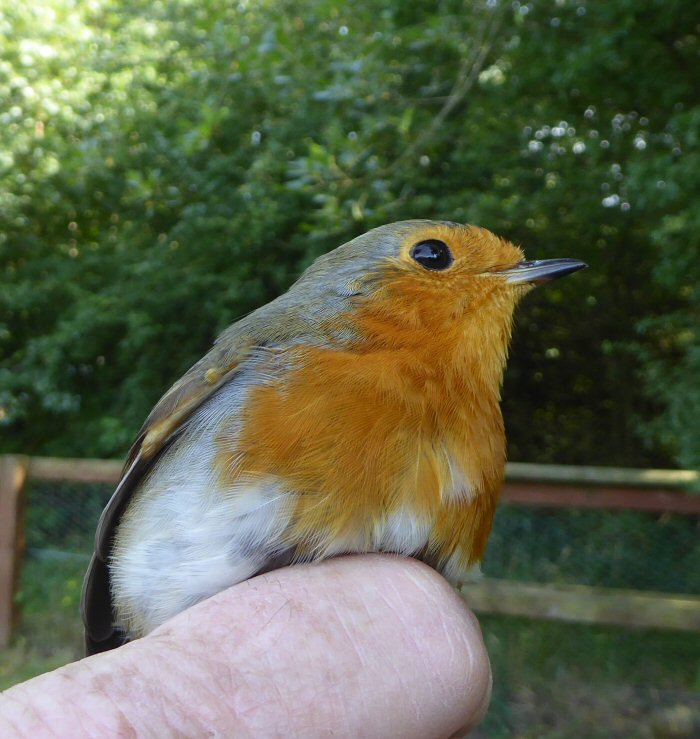
Many visitors have seen the Sparrowhawk fly through and around the back garden. On one of its circuits today it was caught in a mist net. As it was ringed and processed it was found to be a young male born in 2017.
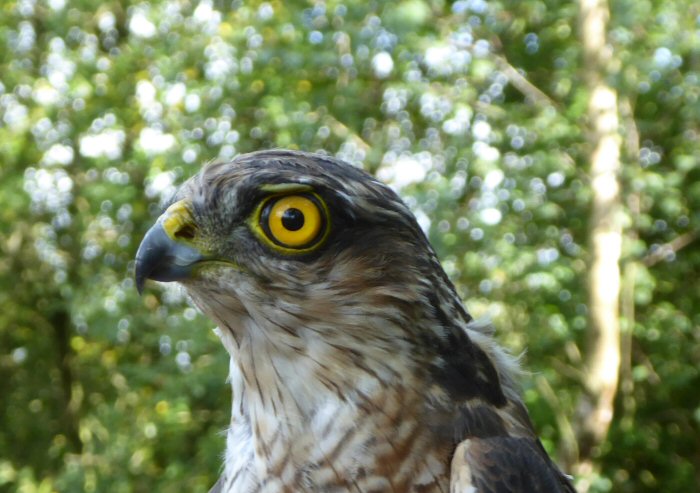
By the afternoon it appeared that many of the Bullfinches were feeding or resting well away from the nets, but the Great Tits were wide awake and arriving in the ringing room in numbers! Many of the 27 retrapped birds had been ringed in the nest boxes. There were some who had nested elsewhere as six Great Tits were newly ringed.
Most Willow Warblers and Garden Warblers have left Foxglove and headed south as the summer season draws to a close. Chiffchaffs and Blackcaps will still be on the reserve for a few more weeks.
In total 180 birds were processed.
As always, ringing is a team effort. A huge thank you to everyone who helped and supported the ringers today.
Crater cutting
Friday, August 24th 2018
We've spent a good portion of today preparing the Crater for the Meadow Pipit (Anthus pratensis) migration; this has involved cutting Net Rides and paths ready for upcoming bird ringing activities on the site where hundreds upon hundreds of these little passerine birds can be caught on a good year.

The Crater was created using spoil that was removed when Catterick Garrison Tesco was made, with the site sitting upon one of the many routes taken by Meadow Pipits as they migrate south.
Although being one of the most common upland breeding birds in Britain, the Meadow Pipit has been placed on the IUCN Amber list of Conservation Concern due to declining numbers since the mid-1970s.
Aside from the transient Meadow Pipits the site is also home to a number of interesting invertebrates, in no time at all we heard the Common Green Grasshopper (Omocestus viridulus), and saw a number of Bumblebee species, as well as this Wall Butterfly (Lasiommata megera).

Unfortunately the Wall Butterfly has suffered a similar fate to that of the Meadow Pipit in recent years, with numbers declining substantially in many inland areas over the last decade.
It's good to know that these threatened species have found a safe place to call home on the MoD Training Estate.
Northern Norway
Friday, August 24th 2018
Members of the Swaledale Ringing Team based at Foxglove have just returned from a bird ringing trip to Norway. The Dividalen Fugelstation (bird station) is within the Arctic Circle close to the border with Sweden. It is in a valley that is used by thousands of birds on their migration.
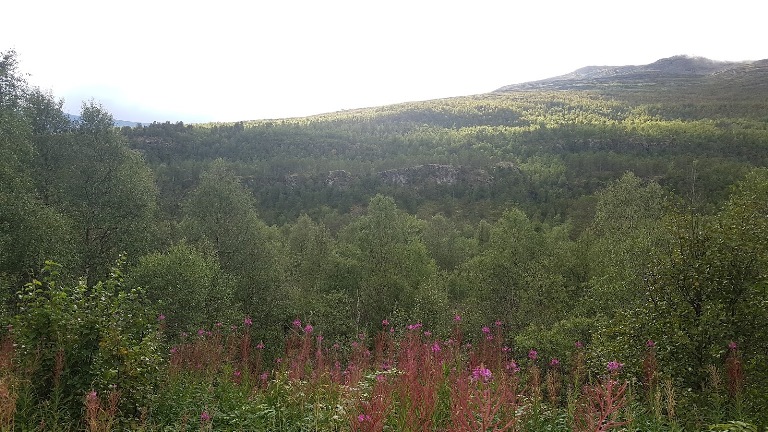
The area is mainly forest and there is a wide river, the Divi, that the birds seem to follow on their routes north or south.
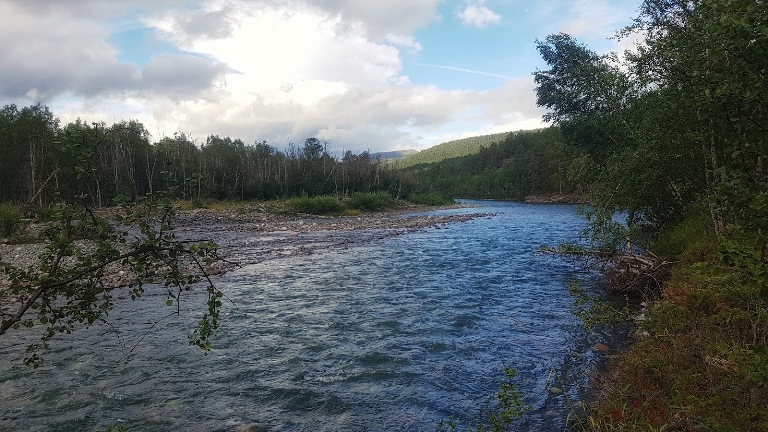
The valley narrows close to the bird station and the birds are 'funneled' in between the steep mountain sides making it a perfect location for the study of migrating birds.The Norwegian ringers use elevator nets which are very tall to catch the birds that fly high in the canopy.
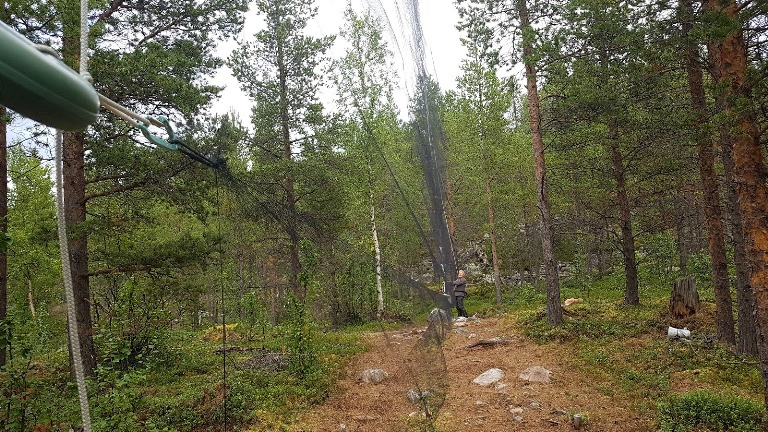
24 hour daylight means that the ringing activities can take place around the clock. During the week 1050 new birds were caught and ringed. Many of the species were new to members of the group such as this beautiful male Bluethroat.
The tail of which is also spectacular.
A juvenile male Waxwing also turned up in one of the nets.
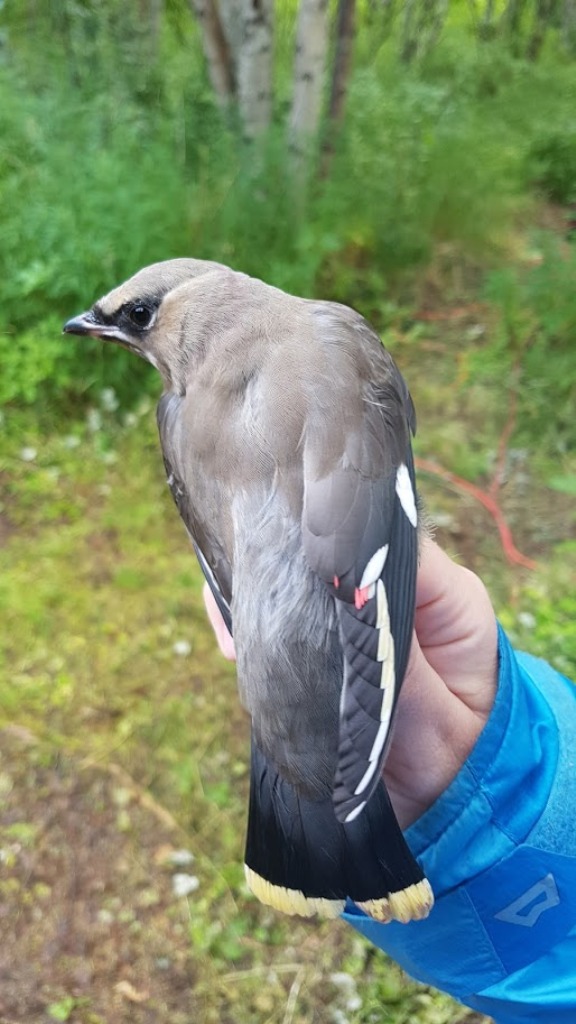
Along with a Yellow Wagtail of the sub species Thunbergi
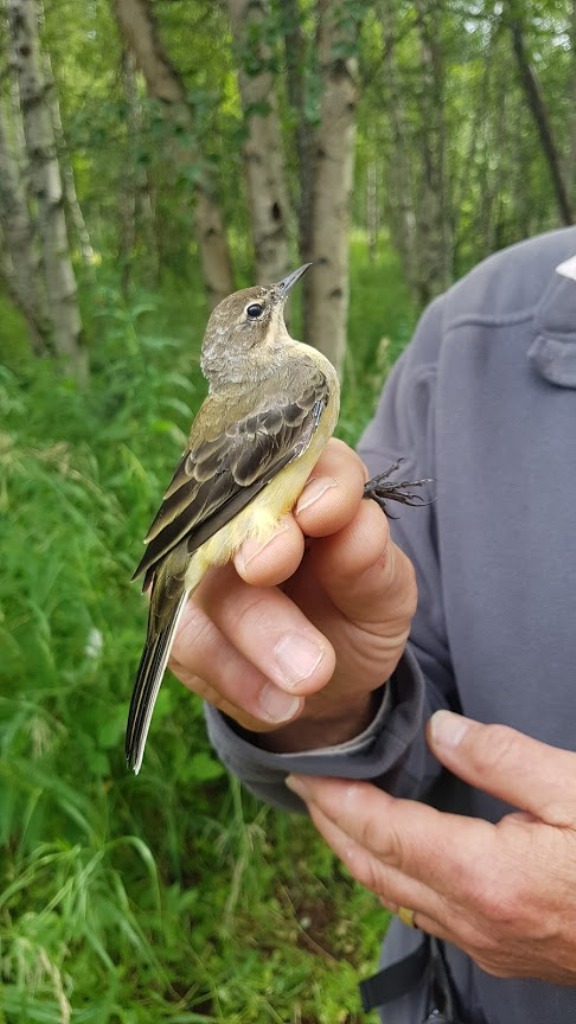
A highlight for all involved was the number of owls caught. Tengmalms owls are common in Northern Norway and have striking eyes!
Hawk owls are slightly larger and much stronger with long tails and fierce talons.
Whilst Pygmy owls are very small (about the same size as a Bullfinch) and placid in nature. We were told they could get into a Great Tit nest box with a 32mm entrance hole!
Another exciting catch was two Siberian Jays. These are rarely ringed and are comical birds in that they make sounds similar to squeaky dog toys! This adult bird was ringed nearly 7 years ago and none had been caught since 2014.
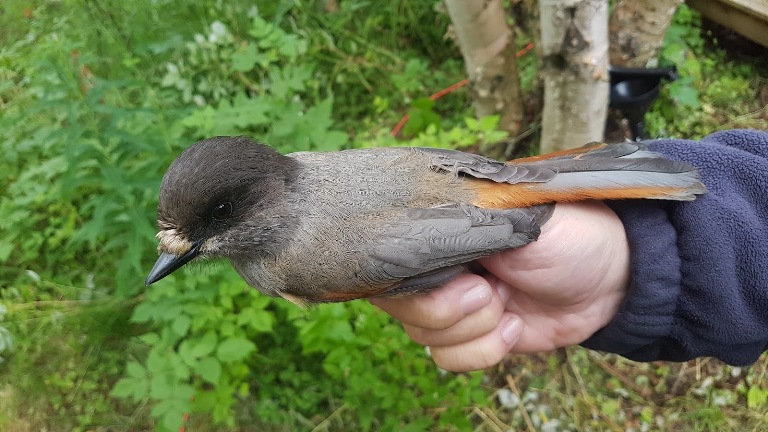
There are many different species of woodpecker in the Norwegian forests such as this Three-toed Woodpecker. This is a juvenile with a white crown which turns to yellow as it gets older.
All in all the week was a huge success. The habitat in this part of the world is outstanding and the wildlife and scenery are spectacular. On the last day the group visited an ancient Aspen forest. The trees were magnificent and much older and larger than any Aspen we had ever seen previously. The understory was rich with flora and fauna creating an extremely special habitat which will hopefully be protected for the future. We were informed that 8500 species of briophytes (mosses and lichens) had recently been identified by a team of visiting specialists before they gave up!
Our thanks go to our Norwegian hosts Vigdis and Karl-Birger Strann for making the week so memorable and to Leanne and Roger for the photos.
A Lordly Visit
Thursday, August 23rd 2018
When expecting a visit from a Lord there are certain standards to uphold!
As such we've been working hard over the last couple of days, tidying and cutting back the fast encroaching vegetation from the main access route.

With preparations in place we welcomed Lord Zetland back to the Reserve along with members of the Management Group, both old and new.

From right to left starting at the back; Major Mick Lynch (Commandant at Warcop and a new addition to the Foxglove Management Group), David Boake (who set up all of the cameras on the Reserve!), Janet Boakes (a new addition to the Foxglove Management Group), Ian Wilson (yours truly), Lawrence Mark Dundas, 4th Marquess of Zetland (Patron of Foxglove Covert LNR), Elizabeth Dickinson (Secretary, Foxglove Management Group), Sophie Rainer (Chair, Foxglove Management Group), and Major Tony Crease (Treasurer, Foxglove Management Group).
Robin’s Pincushion
Wednesday, August 22nd 2018
You may have seen these fascinating structures on wild roses of late; the Robin's Pincushion, is caused by the larvae of the Bedeguar Gall Wasp Diplolepis rosae.

This tiny little wasp will target an unopened bud (embryonic shoot) in which to lay up to 60 eggs using her ovipositor; this acts to alter normal cell development pathways leading to gall formation. The grub then develops inside the gall, and will emerge in the Spring unless tampered with.

Gall wasp grubs will often be predated by birds and small mammals, however there are other threats to the grub that occur within the gall itself.
A bedeguar can be home to a very complex community of insects, as the Bedeguar Gall Wasp grub may share its gall with inquilinus species' such as the grub of the Cynip Wasp Periclistus brandtii. Periclistus brandtii is unable to cause gall formation itself and depends entirely on the galls created by the Bedeguar Gall Wasp.
Unfortunately (for them) the grubs of both Diplolepis rosae and Periclistus brandtii are often parasitised by other insects whilst still within the gall, such as the Chalcid Wasps Eurytoma rosae and Glyphomerus stigma, and also the Ichneumon Orthopelma mediator.

If you've managed to keep up well done, however it doesn't end here! These parasitoids can themselves be parasitised by other insects referred to as hyperparasitoids (including the Chalcid Wasps chalcids Caenacis inflexa and Pteromalus bedeguaris).
On top of all of this insect parasitism the galls themselves are often attached by the parasitic fungus Phragmidium subcorticum.
In short these galls are incredible!
Not just for Mink…..
Monday, August 20th 2018
As usual, Monday started with a look around the reserve. Going out onto the Wetland to check how Lark and Taurus were doing, the persistent calling of a juvenile Buzzard was enough to keep both adults busy. Further round,stopping off at the Easy Access Hide gave a good opportunity to also see the progress of some other youngsters and the four Little Grebe chicks were being given full attention from both parents.

Unfortunately, the chicks positioned themselves very nicely to be obscured by the vegetation but the adults did pose for a couple of shots before disappearing.
As part of the Monday routine, checking the Mink rafts is on the list of things to do. With new rafts and new clay cartridges, it would be interesting to see if this had made any difference. Clearly they had or it had been a very busy weekend.
With six rafts to look at, the first two showed no signs of any activity but after that there was evidence of several different users. The raft checked at the head of the lake showed where Moorhen had been walking across the clay. More surprising was the four-toed prints with no sign of claws. The only mammal likely to be found at Foxglove with four toes and retractable claws is a Cat.
The next raft showed obvious use before even checking the clay cartridge. Small cigar-shaped droppings were on one end of the raft, and one was also on the clay. The prints are much smaller and several showed the three central toes and one splayed out either side to confirm that the droppings came from a Water Vole.
The final raft had larger prints inside, most likely from where the animal had crawled inside the tunnel on the raft. Again this one was four-toed, so not one of the American Mink, Stoat, or Weasel (which all show five toes in a print as clear as this one) and too big for any of those but this time with clear signs of claws.
The toes are splayed out suggesting that there was a lot of pressure put on them as the animal was investigating the raft, and so they are wider than if found when the creature is walking. The size, number of toes and space between the toes and pad suggest that a Fox had been around. Clearly the Mink rafts are not the exclusive preserve of Mink. In fact, thankfully, not one print found on any raft was of American Mink.
Back from Dividalen
Sunday, August 19th 2018
The ringing team have now returned home from Dividalen having had a really good week. They ringed over 1000 birds. Some photos have just been sent to me, unfortunately I do not know the correct names of the birds but in later blogs this no doubt will be remedied. They caught owls. These look more white and grey instead of brown and gold found on our Tawnies and Barn Owls.


Bluethroats were also ringed.
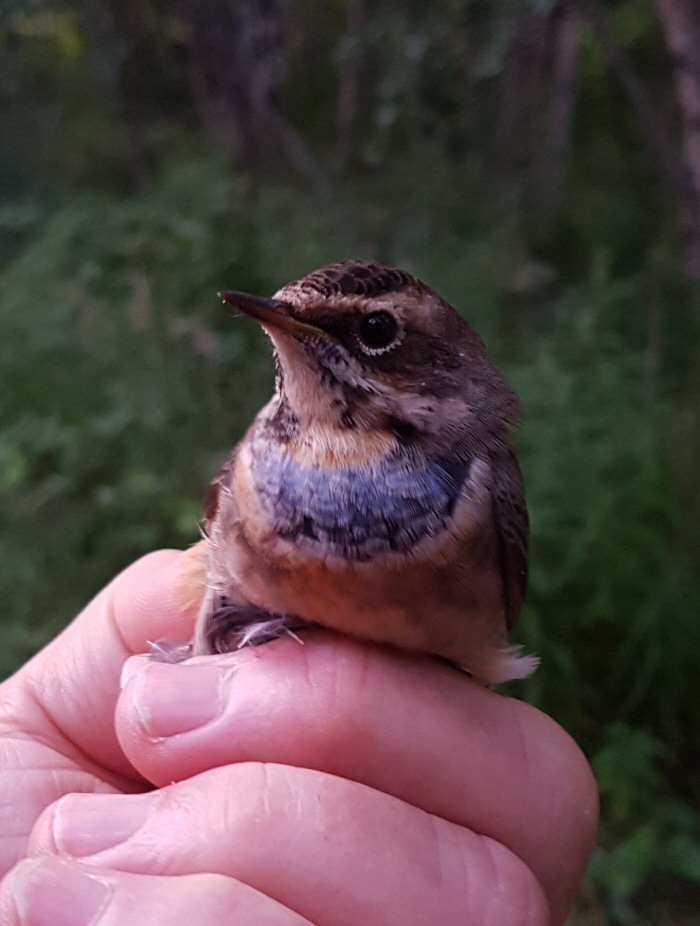
There were also some bugs and beasties around too!

All Sorts
Sunday, August 19th 2018
Devil's Bit Scabious is now in full flower, on the moor, in the small meadows and in the Scrapes.
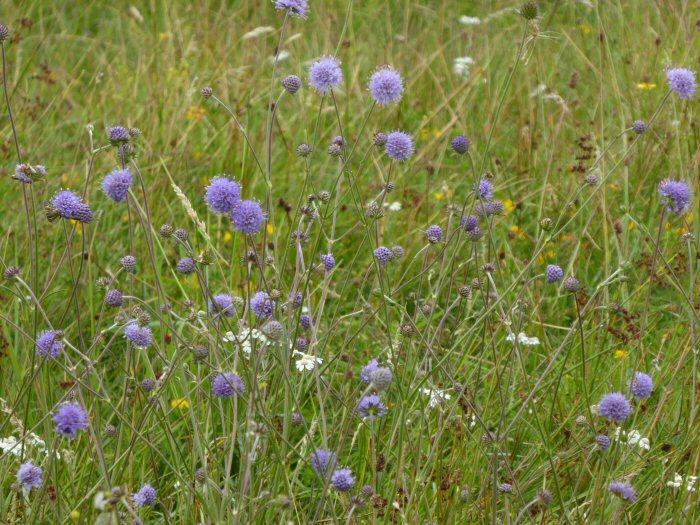
A Peacock Butterfly was feeding from the nectar rich flower.

Comma butterflies can be seen feeding from Hemp Agrimony.

Common Fleabane is growing on an island in the Scrapes and is a yellow background to the red Rowan berries which will soon be eaten by the Blackbirds and Song Thrushes.

Taphrina alni is a fugus that causes a red 'tongue' to appear out of the female catkins of Alder. This was once rare in the UK but is now common.
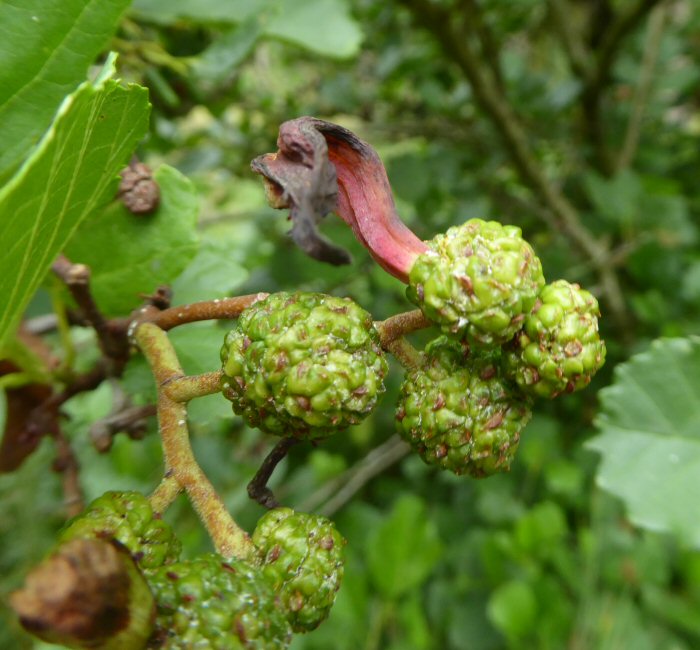
In June we found a single Eyed Hawkmoth. Last week a large green caterpillar was followed as it crossed a path and headed for the undergrowth. Caterpillars can be difficult to ID but this one was soon tracked down as an Eyed Hawkmoth moth caterpillar. They feed on willows and this one was headed straight for a large willow tree!

A Mixture
Saturday, August 18th 2018
Our moth trap continues to reveal some beautiful moths and some surprises. We can identify Antler moths without any problem at all, but we did double check when we caught one that was twice the usual size. The large one is a female and the smaller, rather worn one is the male with feathered antenna. I have left my thumb in place for a comparison. Well actually I was holding the leaves away from the moths and trying to get a photo of both moths before they moved - but it sounds more scientific to say it was for comparison!
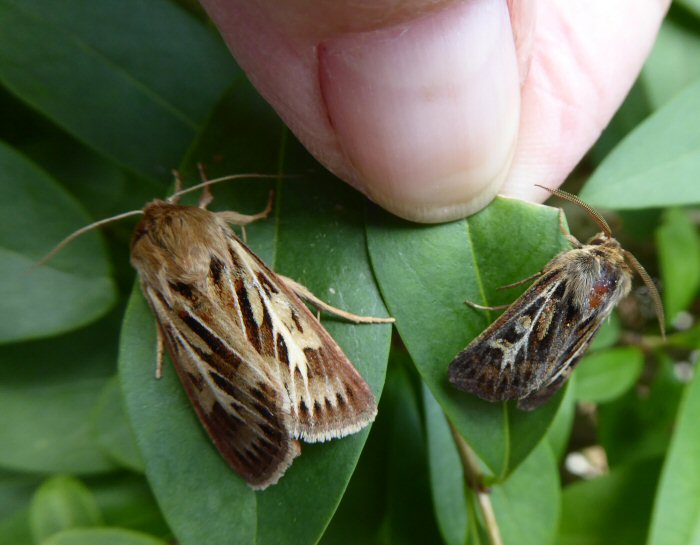
A lovely patterned large moth that we catching is Copper Underwing.
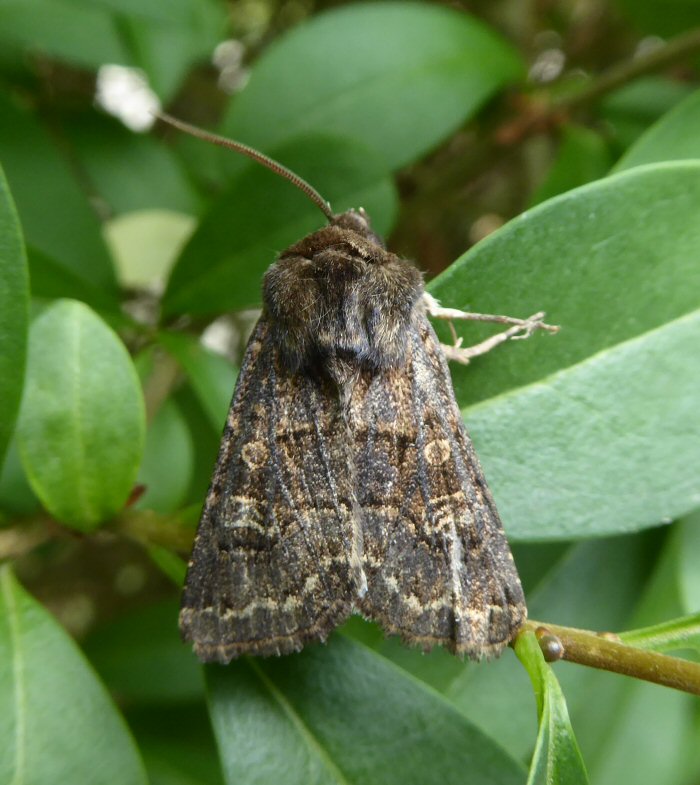
The Cinnabar moth caterpillars on the Ragwort, found earlier in the summer have pupated, having completely eaten all the leaves and flowers on the stalk. Hidden away some late caterpilliars were still feeding.
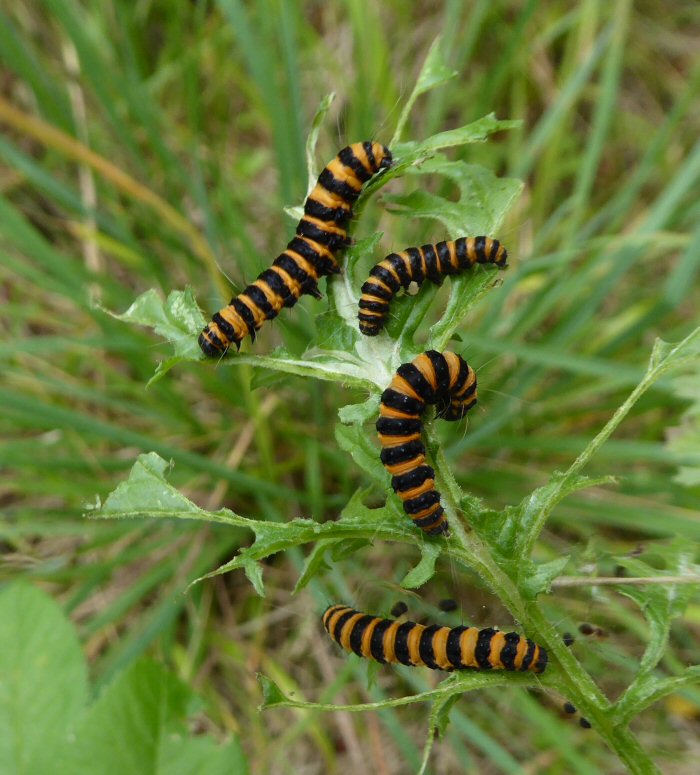
Wild Angelica usually has white flowers and dull green to brown seeds so I was surprised at finding one that was purple.
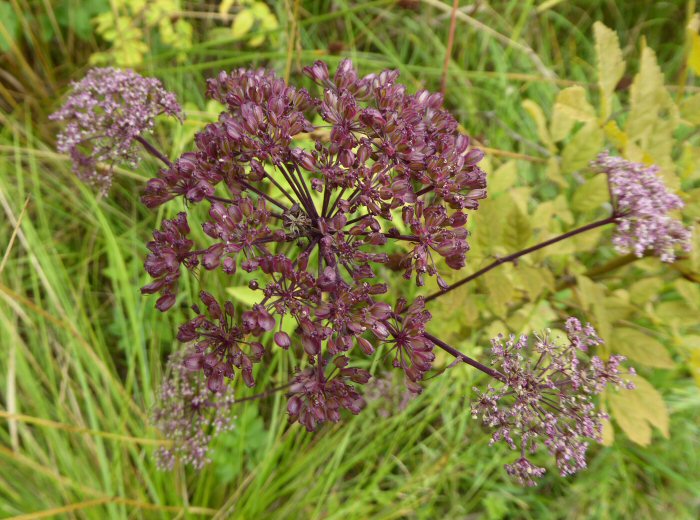
We waited a long time for spring to arrive and then even longer for flowers to appear. White Blackthorn flowers soon covered the trees and now the blue fruits are ripening.

Washing up always takes longer at Foxglove than it does at home as I am always distracted by the birds on the garden feeders. The Long-tailed Tits dropped in to feed and I was able to catch a photograph and can't help but thinking that the one at the bottom is wondering what I am doing.
.jpg)
More on Mink Rafts
Friday, August 17th 2018
The recent pictures of the Water Voles on the Scrapes are definitely good news and, added to the recent sightings on the Wetland, show that we still have a reasonable poulation of these mammals. That makes it all the more important to watch out for predators, and particularly the American Mink.
The efforts by Colin and others to either replace or refurbish the Mink rafts means that all the old ones have now been replaced with new ones. A new Mink raft has also been put out on the Wetland. This has also been an opportunity to replace the clay cartidges in all of them so that the clay is softer and takes a clearer imprint.
After replacing one of the Risedale Beck rafts yesterday, it was the turn of the raft near the Bullet Catcher to be replaced. The new one now has a hinged lid which makes it easier to check the clay cartridge rather than having to lift it out of the tunnel. This means that we now have six rafts around the reserve to show signs of Mink.
Interestingly, before the recent sightings of Water Voles in the Scrapes, the Mink raft there had the imprint of both Water Vole and American Mink. As the Vole print was over one of the Mink prints, it had visited the raft more recently and had taken vegetation there to chew. As there were also droppings on the raft, it suggests that the Vole was reasonably relaxed about being there.
A Day to Complete Projects
Thursday, August 16th 2018
The two Foxglove volunteers in today were able to make good use of their time by completing a number of projects from the last week of work. The weeding of the wildlife garden finished off the garden maintenance on Tuesday along with tidying up some of the leaves and moss that had come down in the wind and heavy rain overnight.
The portakabin was also emptied to be cleaned and tidied which also gave a good opportunity to sort through some of the pond dipping equipment and the collection of wellies and waders. Single odd wellies have been removed and the portakabin is now ready for its next use. The work by Colin to refurbish one of the old Mink rafts meant that we could replace the one damaged earlier this year in Risedale Beck.
The afternoon included removing Ragwort from the Moorland. As the Exmoor ponies will be grazing there later this year, this is a precautionary measure as the plant is poisonous to equine species.
During this process, thoughts turned to the Roe Deer on the reserve and that one of the volunteers had only ever seen one here. We had a quick look into Risedale Beck where the deer are often seen but with no luck. At the end of the day's work, we were in the Field Centre when a visitor who had been up in the conifer woods next to the beck said “You'll never guess what I've just seen”.......at least one family were lucky to get a good view of the deer.
Disappearing Dabchick Chicks
Wednesday, August 15th 2018
Over the last few weeks mother Dabchick has been hopping on and off her floating nest platform made of various collected bits of vegetation (you may have been lucky enough to have seen her frantically flicking loose bits of vegetation over the top of her eggs when startled).
Today however we were greeted by an empty platform.

Thankfully two little chicks were spotted swimming with their parents, however there could be more as young grebes are frequently carried on the adult birds' backs.

Elsewhere on the Lake, the Tufted Ducks have been usurped by Mallards and Moorhens, which have taken over residency of the half submerged tree.

Paths and Ponies
Tuesday, August 14th 2018
The Tuesday volunteer group continued where the Thursday group had finished last week and were able to further extend the new surface on the path down through the Willow Carr area towards the Scrapes.
Luckily, the weather remained dry if dull and so several rounds began of collecting trailer loads of stone, emptying these into wheelbarrows to be wheeled along the path, to be spread out and compacted down. The small group of volunteers were able to lay a further third of the length of path, leaving the final section to be completed later on. Many thanks to those involved for a job well done.
.jpg)
Members of the Yorkshire Exmoor Pony Trust arrived at lunchtime to help move Lark and Taurus from the Heathland. Having spent the morning out in Nidderdale catching one pony who is not always willing to be caught (but wasn't too bad this time), it was the turn of the Foxglove Two to decide if they were going to be amenable or not. Despite initial diffidence, Taurus soon gave in to the temptation of a piece of carrot and the head collars went on easily.

The only problem during the walk across to the Wetland was the three cars coming the other way as we went past the Visitor Centre. The behaviour of the boys was immaculate as they moved off the road and waited patiently for the vehicles to pass. Taurus obviously knew where he was going as he got more visibly interested as they walked through the conifers with the Wetland in sight.
The final task for the day was to cut and strim the grass around the Field Centre. This has been left during the long hot, dry spell but is now starting to shoot away again. No doubt we will be returning to this very soon!
Water Voles back on the Scrapes
Monday, August 13th 2018
A big thank you to Ian who came in this morning to finish cutting the hay meadow with his topper. It will be very interesting to observe the meadow change over the coming years and to see what effect a combined drought and high yield of Hay Rattle (Rhinanthus minor) will have on the sward density next year.

We have been seeing increasing signs of Water Vole activity on the Scrapes over the last couple of weeks after months of little activity. Finally, two were seen on the Scrapes last Friday, and then one was photographed by Elizabeth today!


Flowers and Backgrounds
Sunday, August 12th 2018
Most of the Dog Daisies along Dog Daisy Avenue are setting seed but there are still some in flower in the Scrapes.
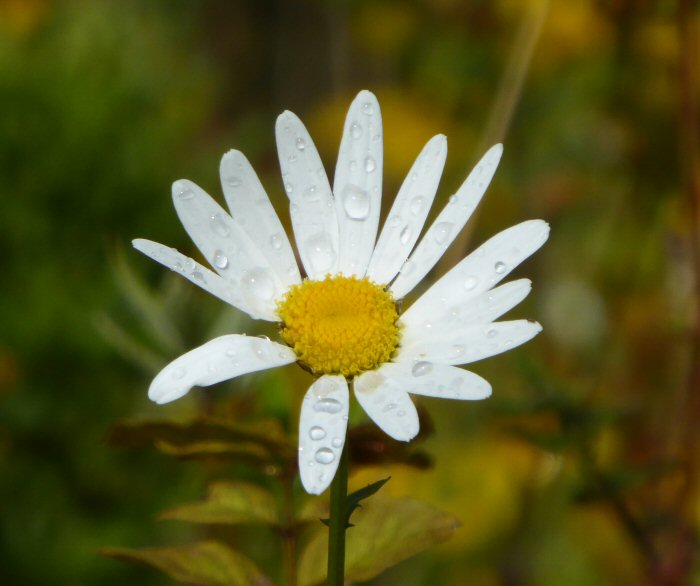
Meadowsweet can be found in profusion in the hedgerows across the moor.
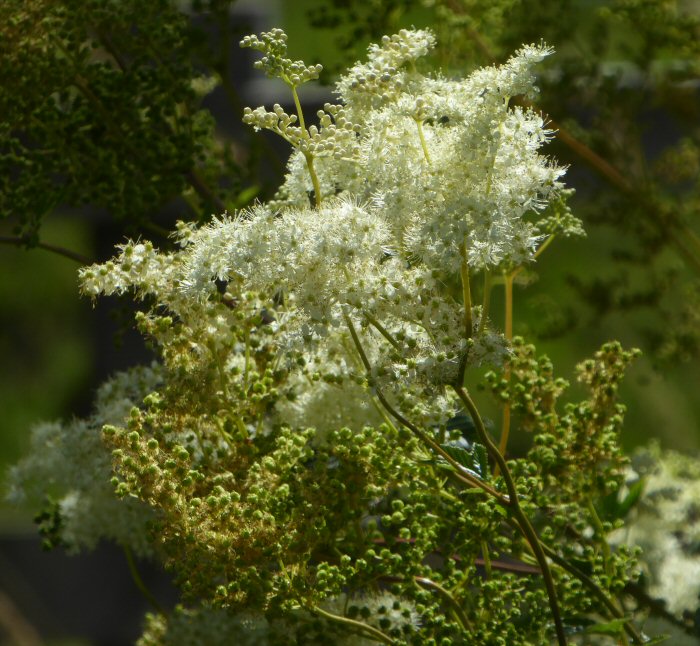
Wild Carrot is a late flowering umbelifer. Last year most flowers had the tiny red centre petals. This year I haven't found one that has, they are all white!
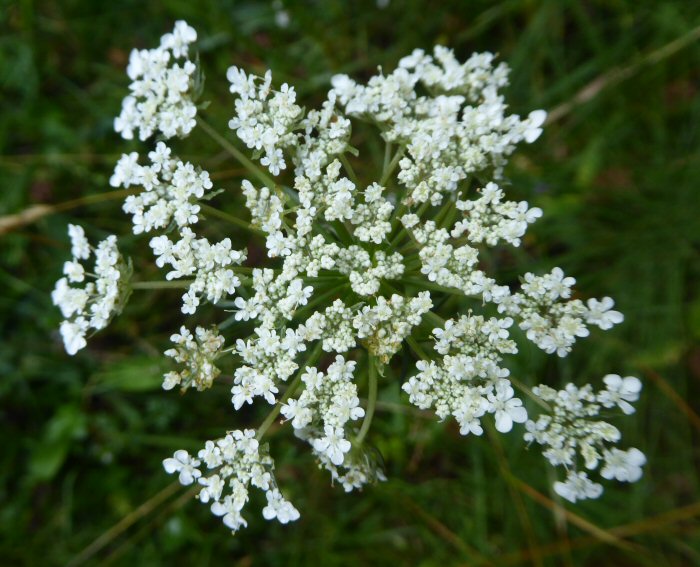
One of the last flowers to be recorded during the summer is Grass of Parnassus. This is a beautiful flower.
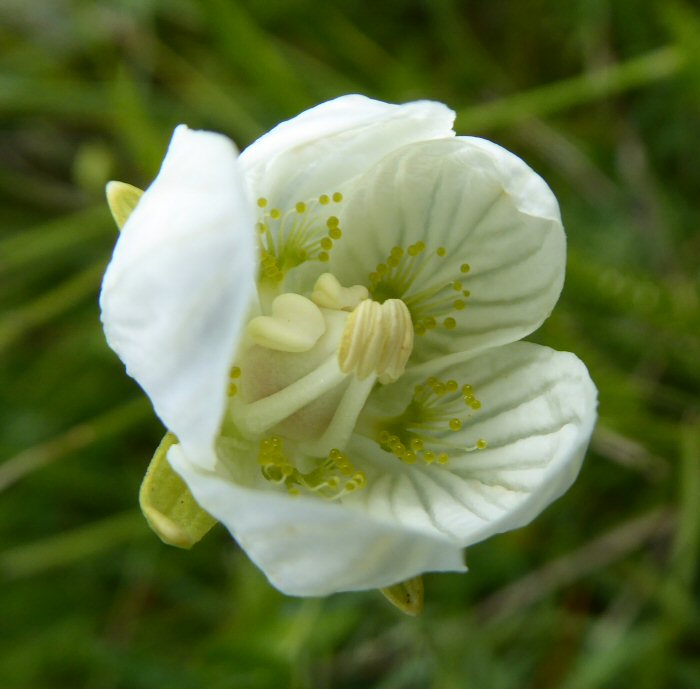
Another late summer flower is Devil's Bit Scabious which provides a great source of food for many insects, including bees and hoverflies.
.jpg)
Although it has been very dry, there is still a lot of colour around the reserve. There are beautiful backgrounds for photographs, if the insect being photographed obliges and sits there. This female Common Hawker was very co-operative. She landed and stayed in one place for a reasonable length of time,allowing us to take some photos. I will leave you to decide on the background!
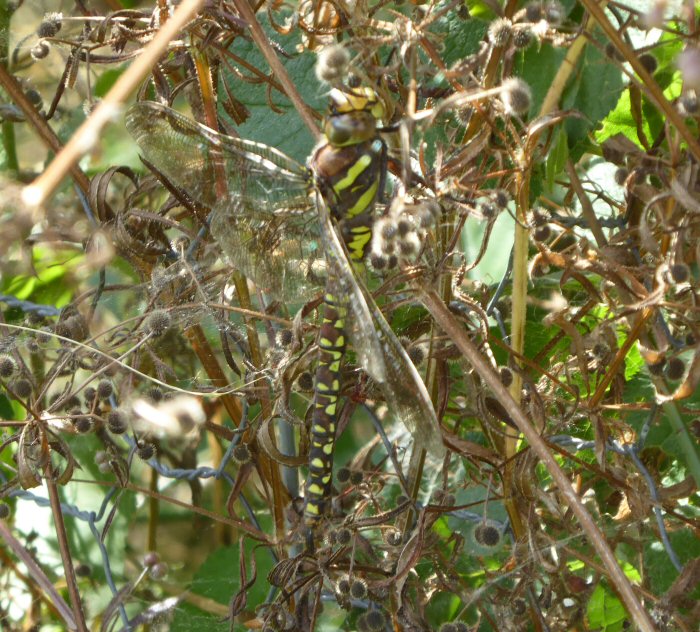
Walking with a Camera
Saturday, August 11th 2018
I rarely go out into the reserve without my camera. It is sometimes amazing what you can find. Looking at marks on the leaves of Rowan, we turned them over to be met with sputnik looking things. We presumed that they were galls of some sort and when we checked we found them to be Gymnosporangium cornutum, a rust gall. This is a new species for the reserve.
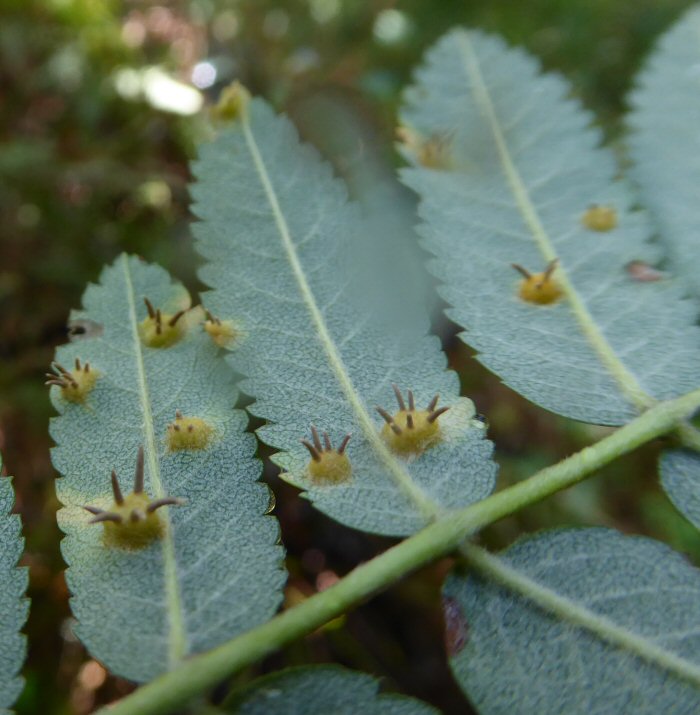
No ringing tomorrow and as rain is forecast it could well be a day to update the species list and check the number of new species recorded over the last few months.
Some members of the bird ringing team are heading to Dividalen in Norway again, for a week of bird ringing. They will have to remember the different birds they caught last year and to ring on the left leg, not the right as we do in Foxglove. As there are no signals for communications so far north, inside the Arctic Circle, we will have to wait until they return with many photographs of their activities.
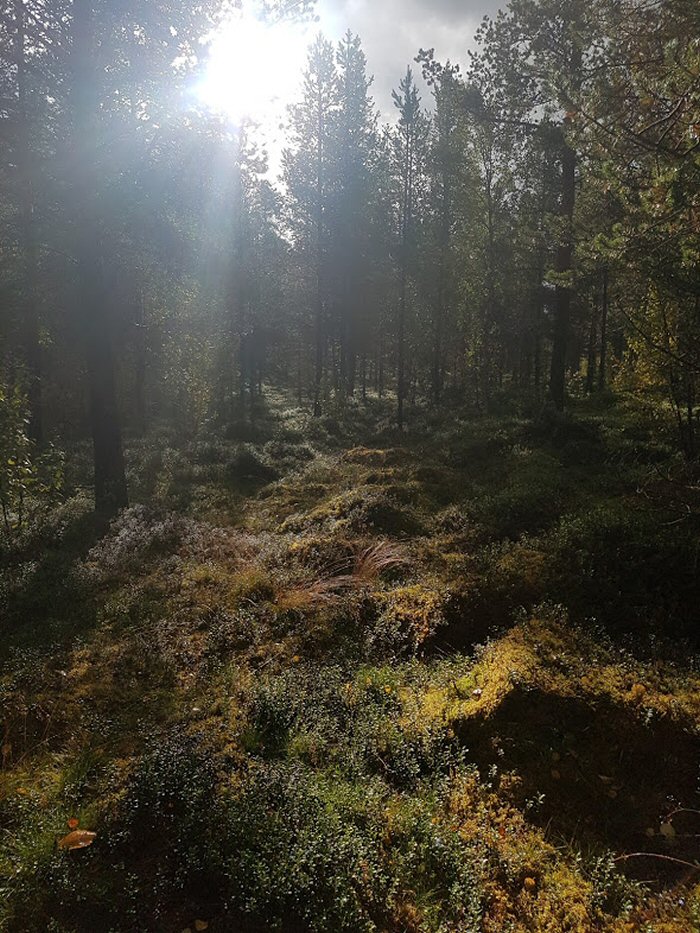
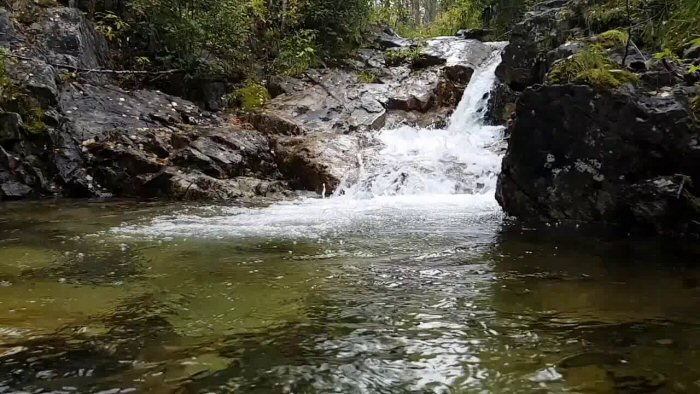
A slight detour from walking with the camera around Foxglove!
We wandered into the Winter Seed Crop area and were really pleased with the way that it is developing.
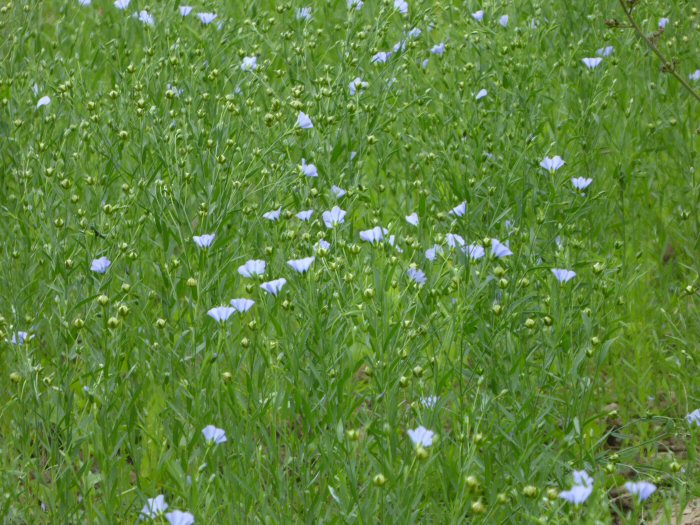
The area has been ploughed for several years and each year there is an improvement. Many of the stones have now been removed!
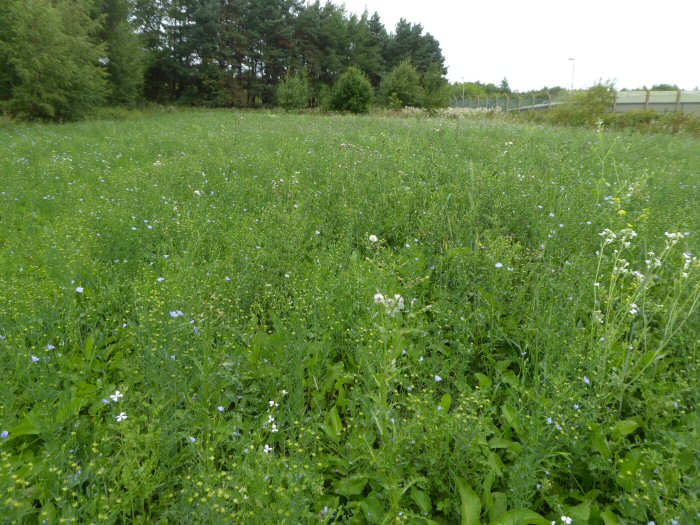
There were many spiders running around. Running is emphasised as there was no way a photograph could be taken. A Small Copper butterfly was enjoying the sunshine in amongst the flowers.
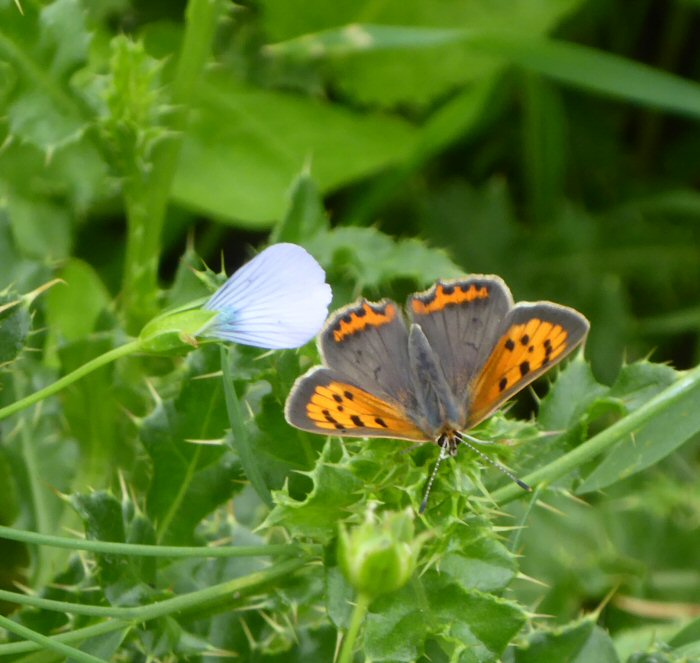
Along the edge of the field is the conifer block and it provides several sunny glades that were being enjoyed by Speckled Wood butterflies.
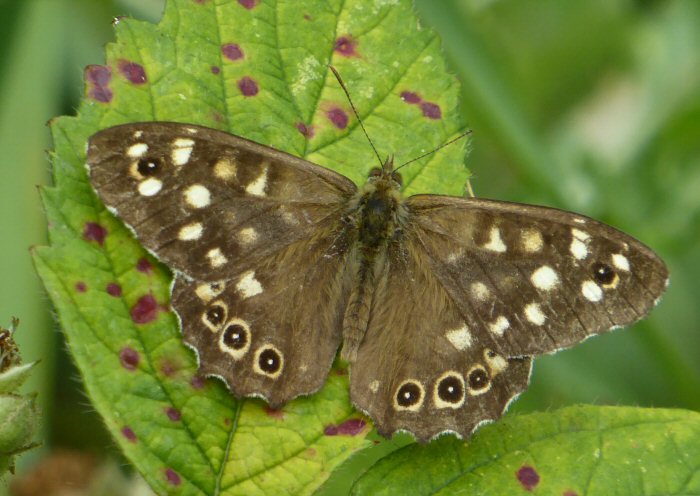
Hemp Agrimony attracts many butterflies and this Red Admiral was drinking the nectar.
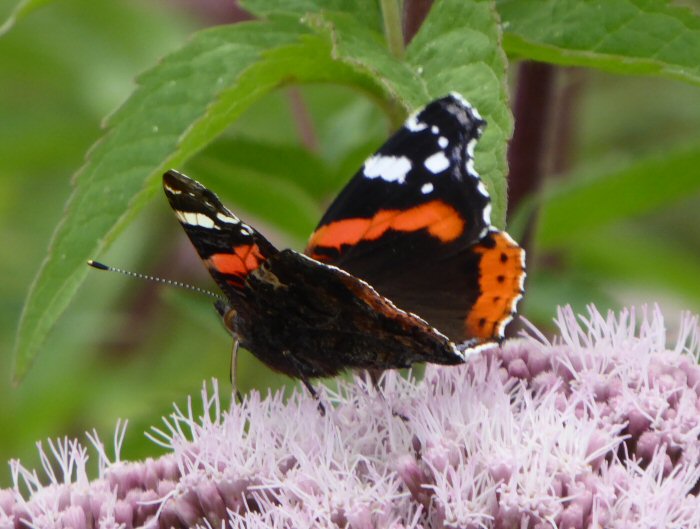
Harebells are beautiful, now growing at both ends of the moor. We assume that plants grow where the conditions are just right for them. These Harebells are growing in the middle of Gorse!
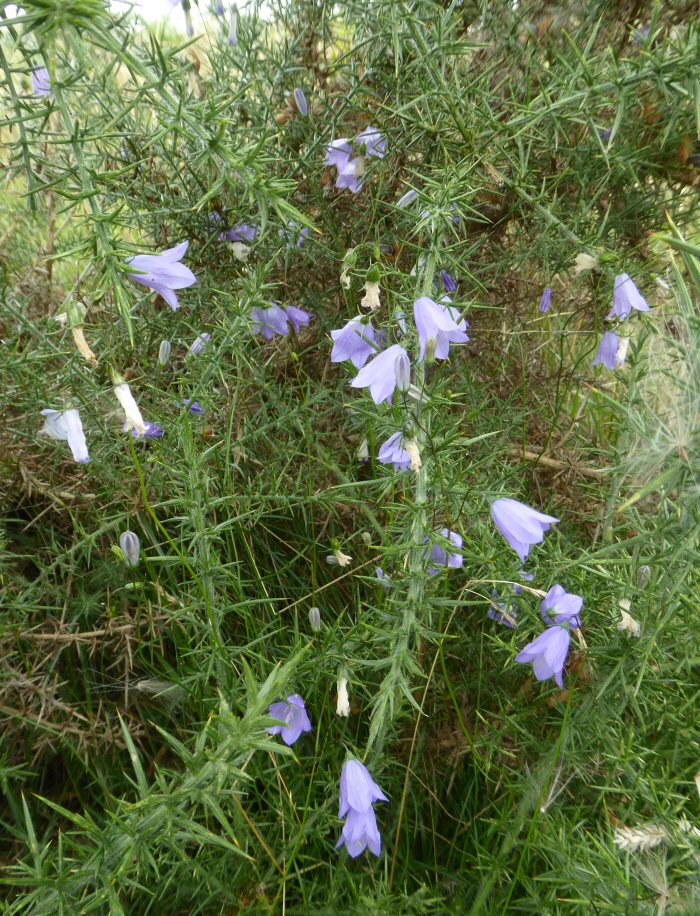
April Showers?
Friday, August 10th 2018
Weather forecast reported Friday would be dry, with a little bit of wind. It changed and the report was light rain. What we actually got was really heavy rain showers which included hail and possibly snow, unless our eyes were deceiving us! When the showers appeared, the bird ringers checked the nets continuously and where there were many birds there were many bird ringers.
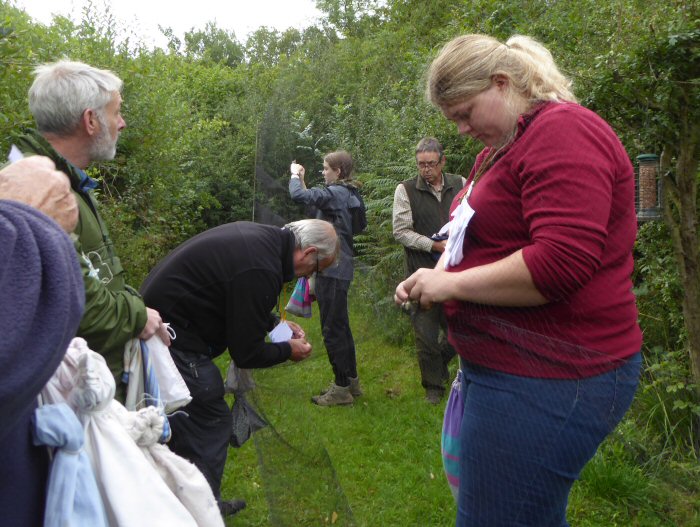
At the end of the day everyone helped to take down the nets, some of which were very wet.
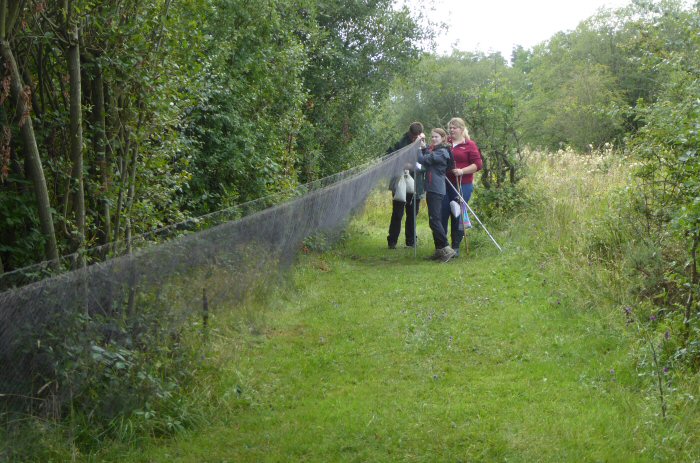
CES 10 was reasonably busy with over 200 birds processed. Again most birds through the ringing room were juvenile birds, many now well through their post juvenile moult. On the last net round quite a special Willow Warbler was caught. When the ring was checked and then double checked it was found to be a bird originally ringed in Spain. We will receive more details about this bird in due course. It was the first Spanish ringed bird ever caught on the reserve.

It was a very tiring and demanding day due to the weather conditions. A huge thank you, as always, go to the bird ringers, and to those volunteers who helped prepare the net rides ready for today. Not forgetting Colin who filled the feeders.
Down on the lake The 'Tufties' were keeping their feet dry.
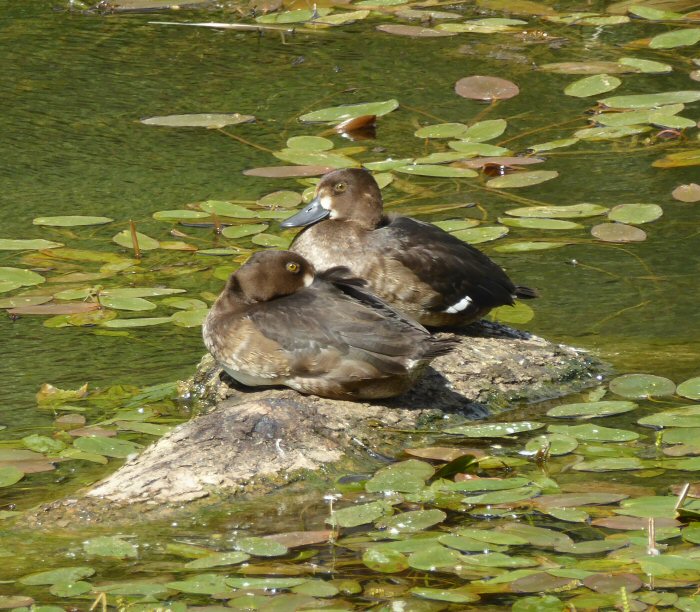
Deer Signs
Thursday, August 9th 2018
Foxglove has a healthy population of Roe Deer (Capreolus capreolus), and the evidence from sightings and camera traps suggest that it has been a successful year for breeding with at least four fawns seen. Not everyone is lucky enough to see them, especially in the Summer when they are more secretive and the leaves on trees make it easier for them to hide from human view.
However, there are still a number of signs of them around. A group of Willow trees near to the lake seems to be a favourite place and these have been used for the bucks to rub the velvet from their antlers in the Spring once these have stopped growing. Known as 'fraying', the bark of the tree is not stripped away but is broken up by the rubbing up and down of the hard material of the antlers.
Roe deer have also been using these trees during the Winter and early Spring to reach the sap underneath the bark. This can be more serious for the tree as, if they strip the bark from around the trunk, it can kill the tree. In the photo above, the stripped areas are showing how the tree is starting to heal with growth closing over the exposed wood.
July and August are also the time for other signs. Forget the Red Deer rut often shown on BBC's Autumnwatch, as now is the time when strange rings appear, often known as 'fairy rings'. These are the result of the rut for Roe Deer, and are the final part of the ritual where the Doe has led the Buck on a chase and he has finally met with her approval.
Dipping for sub-aquatic beasties
Wednesday, August 8th 2018
On today's Pond Dipping - Discover the Depths! event we were running all three dipping platforms for the first time this year.

Our 22 strong group of Pond Dippers found all manner of things, including various beetle larvae, fish, midge nymphs, water boatman, dragonfly and damselfly nymphs, pond skaters, whirligig beetles and two Great Diving Beetles.

Great Diving Beetles undergo complete metamorphosis, meaning that they have a four staged life cycle; egg, larva, pupa and adult, with some living for up to 3 years in their adult form!
If you cast your mind back to the 11th June I mentioned that the Great Diving Beetle larvae was a 'fierce predator', the same can certainly be said of the adult form, which will also hunt smaller invertebrates, tadpoles and small fish.

Aquatic beetles began colonising the land having evolved over millions of years, and as such still rely on atmospheric oxygen, returning to the surface of the pond to replenish their supply of air which they store beneath hardened fore wings (elytra) which also serve to protect their membranous hind wings.
Despite being so heavily armoured adult Great Diving Beetles are able to fly, and will do so when colonising new ponds. They will do this when competition for food is too high, in order to search for mates, or to find more suitable habitat.
It is plausible that a few adults many have chosen the bottom pond on the Scrapes because it is deeper and so less likely to freeze all the way to the bottom in winter, allowing them to hibernate in the plant matter and detritus at the bottom.
Meadow and path maintenance
Tuesday, August 7th 2018
We've had Ian Tunstill in over the weekend to cut the Wildflower Meadow; as expected yield is down due to the drought and the Hay Rattle (Rhinanthus minor) doing an excellent job of parasitising the grass species that make up the bulk of most hay crops.
Over the next few years we expect to see more wildflower species taking the place of these grasses in the sward, with the eventual return of grasses and fluctuation of Hay Rattle across the meadow year on year.

Today the cuttings have been raked into piles, ready for the baler to come and gather them into bales.

Meanwhile, some of the volunteers have been continuing path works, now moving away from the boundary path and leaving over 20 metres of pristine path behind them. Elsewhere others have been continuing to remove thistles from the Moorland.


All About Pillwort
Monday, August 6th 2018
I admit that we do get excited about creepy crawlies and bugs and beasties and we don't leave out the plants, colourful, large, small and green. Falling into the green category is Pillwort. This rare fern grows in water or in mud at the edges of ponds. It also grows in deeper water sending its roots down to the silt.
You can see the unfurling fronds in this photograph.
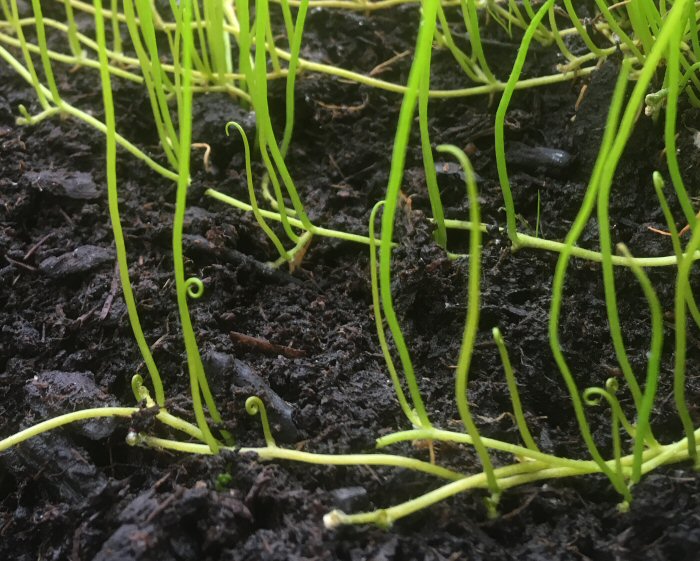
Land ferns produce the spores on the back of the fronds, but Pillwort develops its spores in small round pills, growing where the frond rises vertically from the horizontal stem.
.jpg)
A project of the Freshwater Habitats Trust is to return Pillwort to ponds where it once grew and also to translocate some to other ponds in areas where it is growing. With this brief we checked that 'our' Pillwort was still growing on the wetland and we were pleased to note that not only was it still there but its area had increased.
Two years ago a small amount had been placed in another pond and it is thriving. We marked its location and its GPS was also recorded.
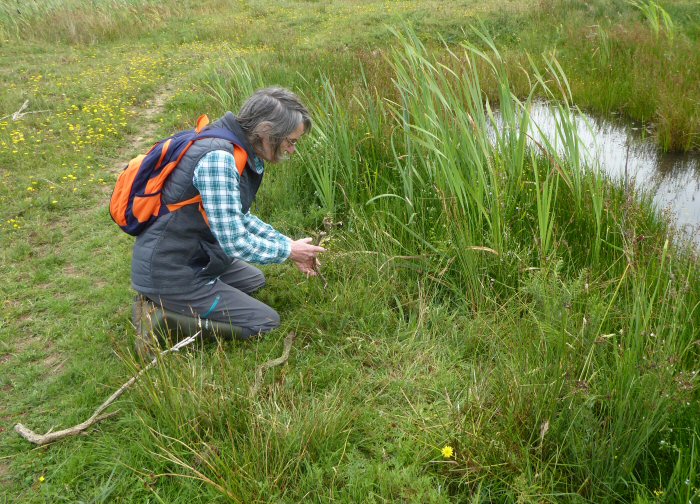
Two weeks ago some Pillwort, from our ponds, grown in containers was transplanted into Plover's Pool. Some more was added today. We will monitor all our areas of Pillwort to see how it develops. All our information will be sent to the Freshwater Habitats Trust.
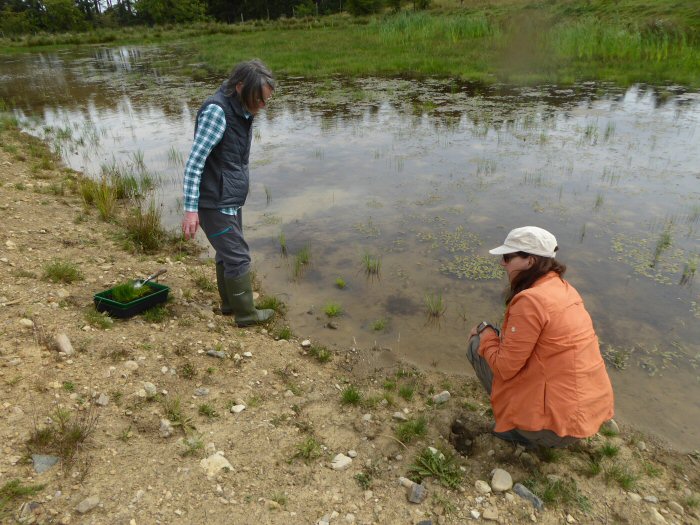
Thank you to Anne Carter of the Freshwater Habitats Trust for her guidance and support.
Whilst working, a Water Scorpion was found, unfortunately it was covered in mud so instead of being nice shiny black it was dull brown.
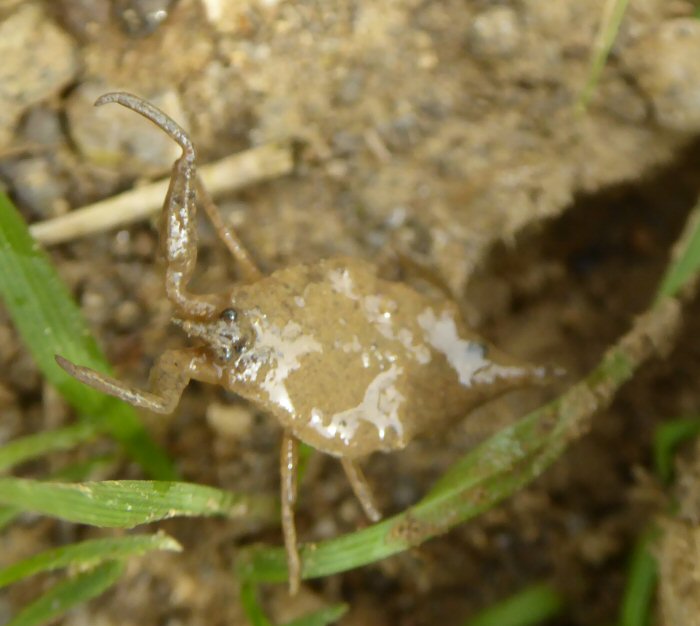
Reedbed Ringing and Wonderful Warblers!
Sunday, August 5th 2018
The Swaledale Bird Ringing Group from Foxglove is very privileged to be able to ring on a stunning quarry site called Bellflask. Gravel lakes with extensive reedbeds provide a fantastic habitat for an enormous variety of wildlife. The site was alive with weird and wonderful waterfowl calls today as 11 mist nets were placed in net rides through the reeds. The morning was a productive one with some beautiful birds turning up in the nets. Three juvenile Kingfishers were ringed.
A special overlapping ring is fitted to these birds as there can be a variation in the width of the tarsus. So unlike most species one size does not fit all and the rings are 'tailor made' for each individual. The same ring is used for Kingfishers and Swifts both of whom have very short legs!
Bellflask is particularly important for the species of migrant warblers that breed there including this juvenile Sedge Warbler which was the first one caught there this year.
Reed Warblers are naturally in the greatest numbers as much of the site consists of phragmites. Judging by the number caught this morning (36 in total) they have had a successful breeding season. These birds are summer visitors to the UK and will soon be starting their incredible migration to Africa where they spend the winter months.
News Roundup
Sunday, August 5th 2018
Some numbers first. The Bug Hunt actvities on 1st August resulted in 46 different species being recorded, with possibly some new species included, but these still have to be checked. Watch this space. The moth night resulted in 125 species of which 10 were new species. Some moths were caught in large numbers. Bird Cherry Ermine 76, July Highflyers 180, Antler Moth 96 and Large Yellow Underwing 133. The bats that fly around Foxglove have plenty food.
Jack, down on Salisbury Plain sent an email - 'Dry weather meaning no water at all on the Eastern side of the plain for several months has seen many species finish breeding earlier than usual. Odd Yellowhammer and Linnet still going, but pretty much over. Pictures are likely to be the last newly fledged Whitethroat of 2018 for me.'
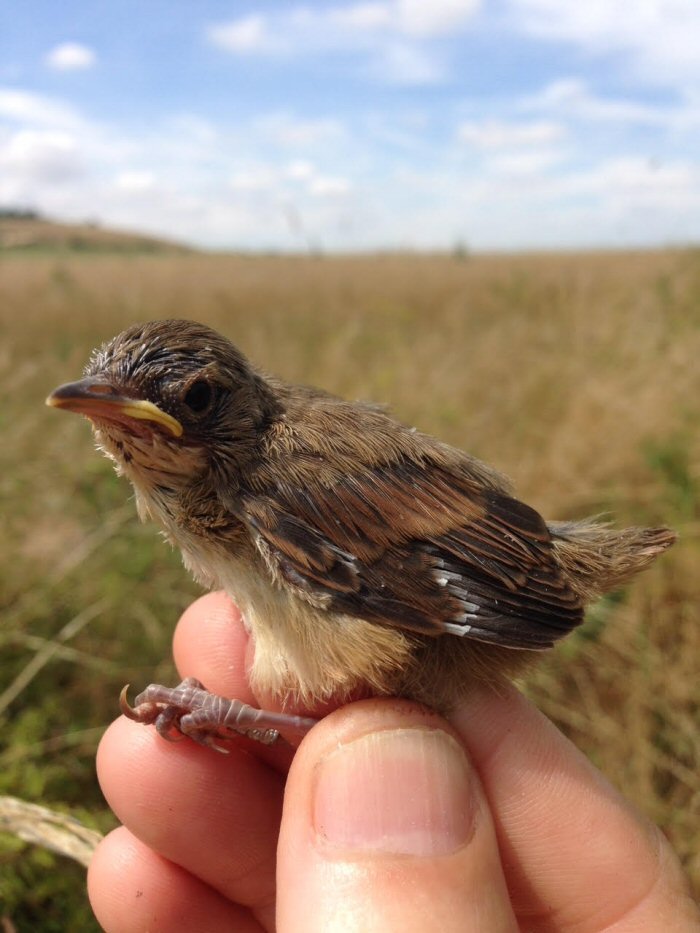
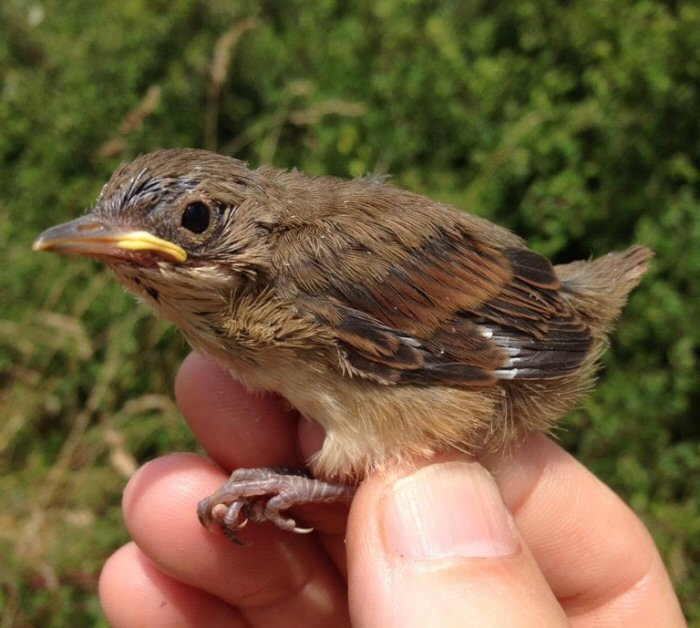
Over the last week the bird ringers have been cutting net rides in the reed beds at another site.
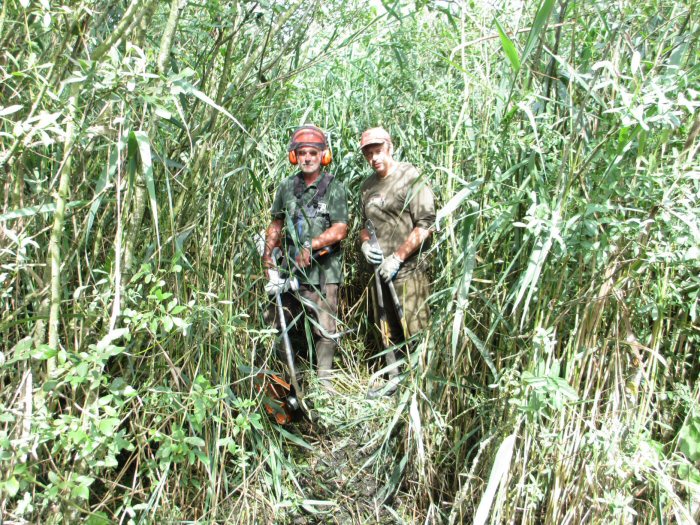
Once cut the rides have to be tided.
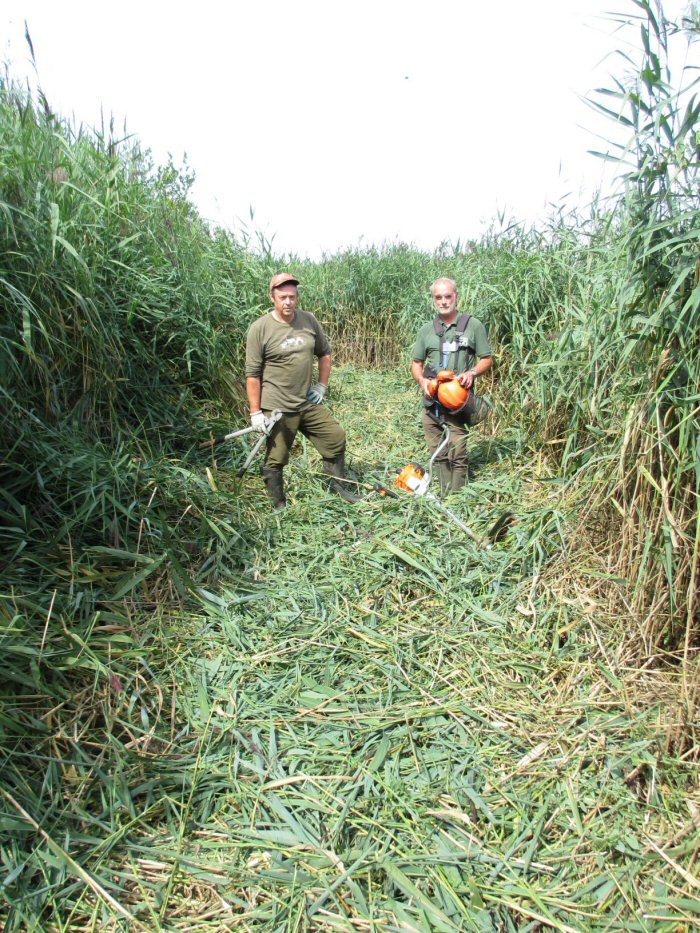
Over winter the duck trap catches a variety of water birds. During the summer it has trapped lots of vegetation!
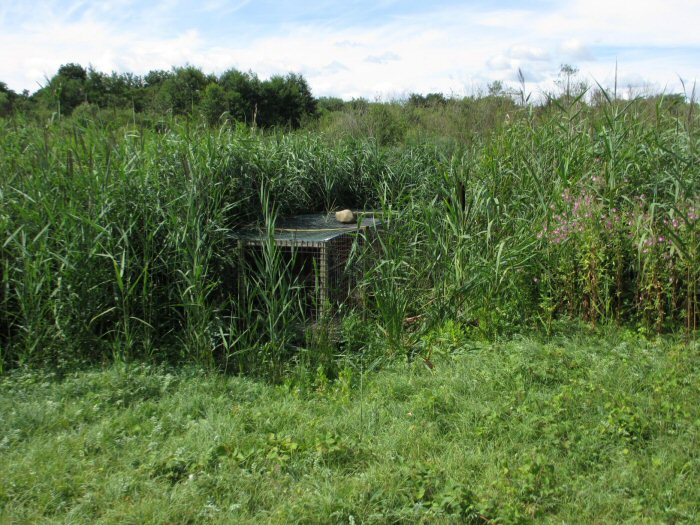
Some hard work, especially in the hot summer sun, and a duck trap re-appeared.
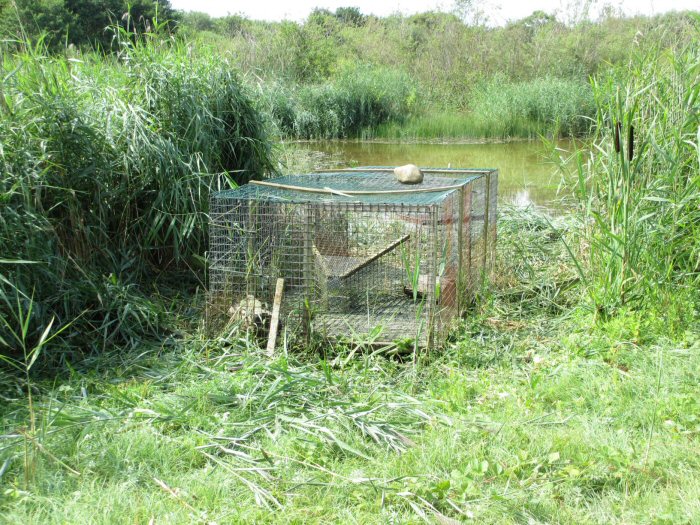
At Foxglove, flowers are coming into bloom but 'going over' quite quickly. Hemp Agrimony is just beginning to flower.
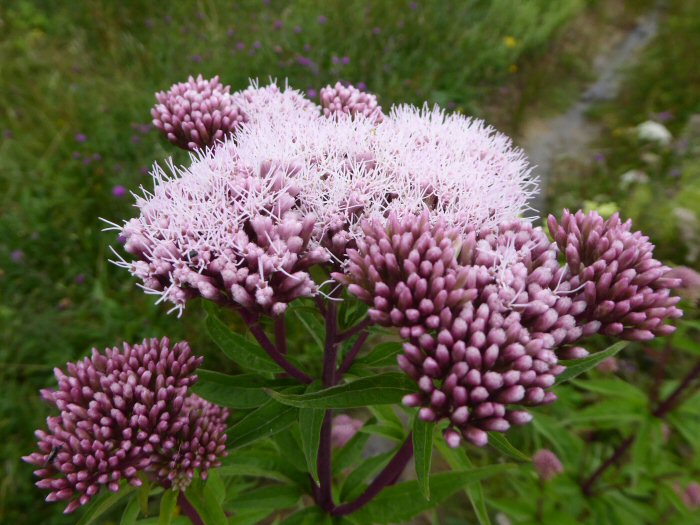
Through the Scrapes the vivid pink of Purple Loosestrife shows through the Phragmities.
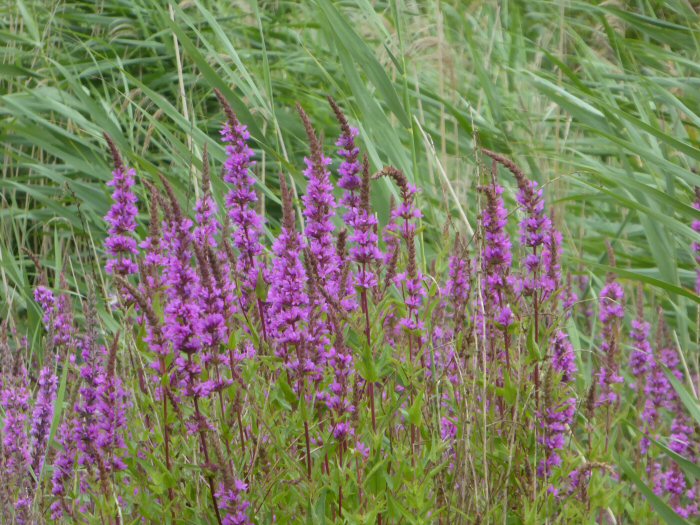
Teasel is a very prickly plant but it is loved by many insects.
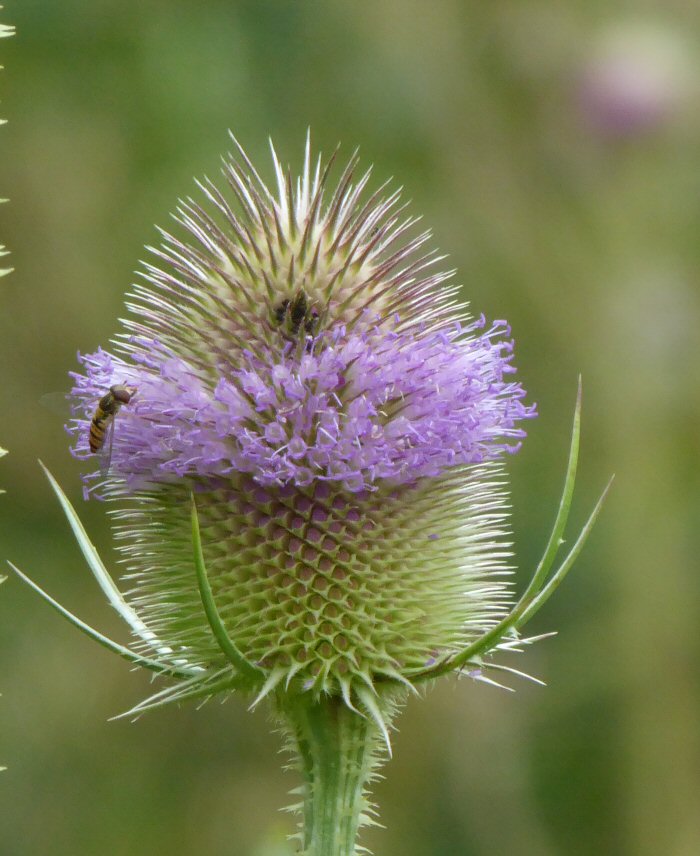
More Wings!
Saturday, August 4th 2018
Last night seven moth traps were spread around Foxglove. It would have been interesting to have a drone fly around, seeing lights in the undergrowth! Early this morning the traps were collected and returned to the Field Centre where they were emptied and the moths identified.
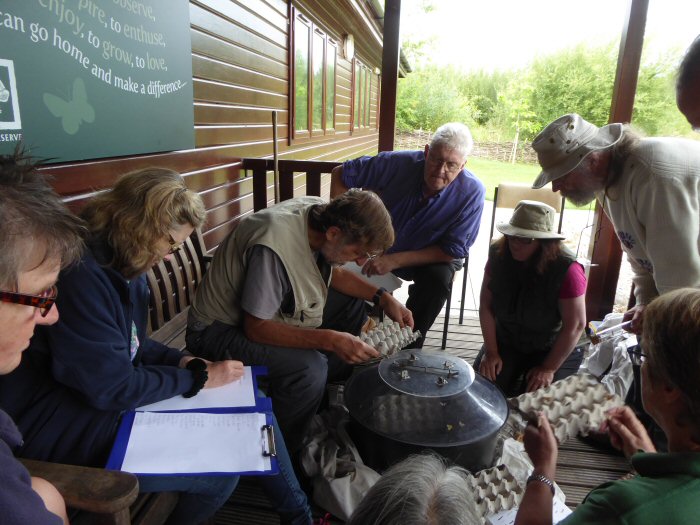
Lots of egg boxes and of course cups of tea!
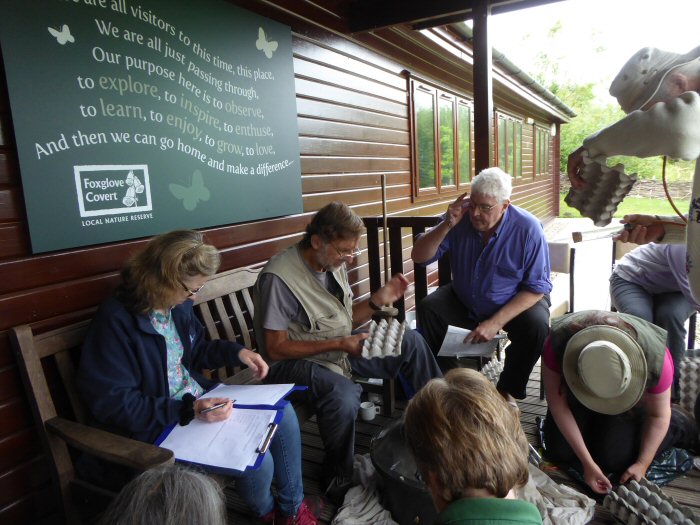
Dr Charlie Fletcher, the VC 65 moth recorder, identified the moths, including the micros, that we struggle with on a Wednesday morning. Amazingly Jill Warwick recorded all the moths, including all the Latin names. Wow what a job! We will receive a full list of all the moths and the numbers shortly. These are then entered into our Species Program.
The traps do not just catch moths but other insects too. There was a wasp and the beetle Nicrophorus investigator with its accompanying mites, some beetles and many insects. Caddis fly experts caught many different caddis flies and will send us a list of species. These too will be entered into our Species List Program.
Volunteers and visitors were shown the moths and given indicators to identification.
Now we come to the 'wings'. I apologise if some of these moths have been on the blog recently but they are all so beautiful, (I know some readers of this blog will not agree!) I could not resist taking more photos and giving them their time in the limelight.
This is a Purple Thorn, distinguished from all the other thorn moths by sitting with its wings cupped. A head on photo shows its furry antenna and its slightly uncurled proboscis. The larvae feed on a variety of deciduous trees.
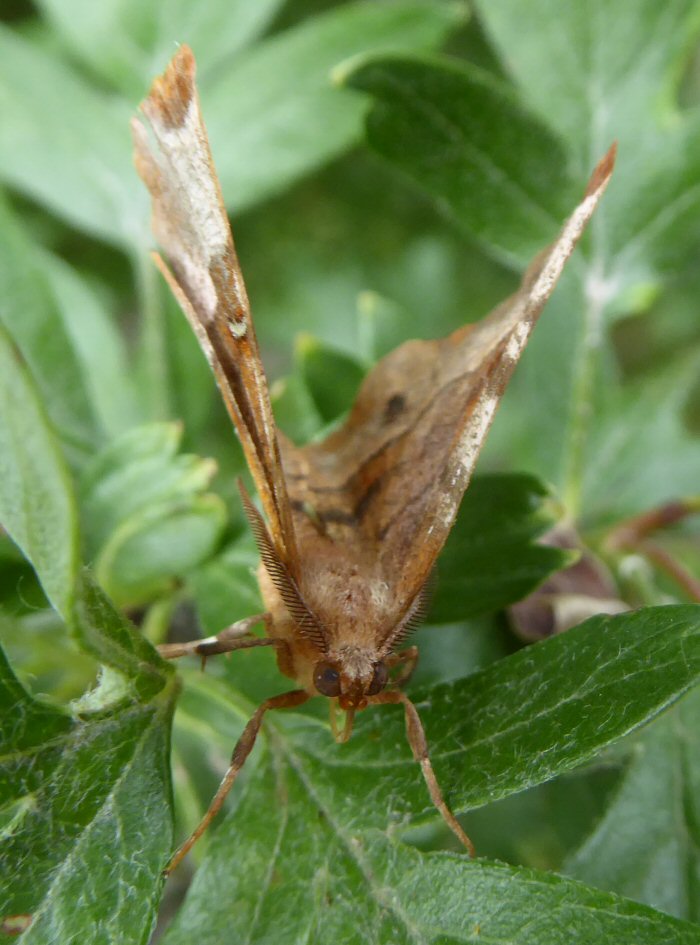
Canary-shouldered Thorn is a bright yellow moth and often leads us a merry dance when we try to photograph it. This one sat still. We should be catching this moth well into October, weather permitting.
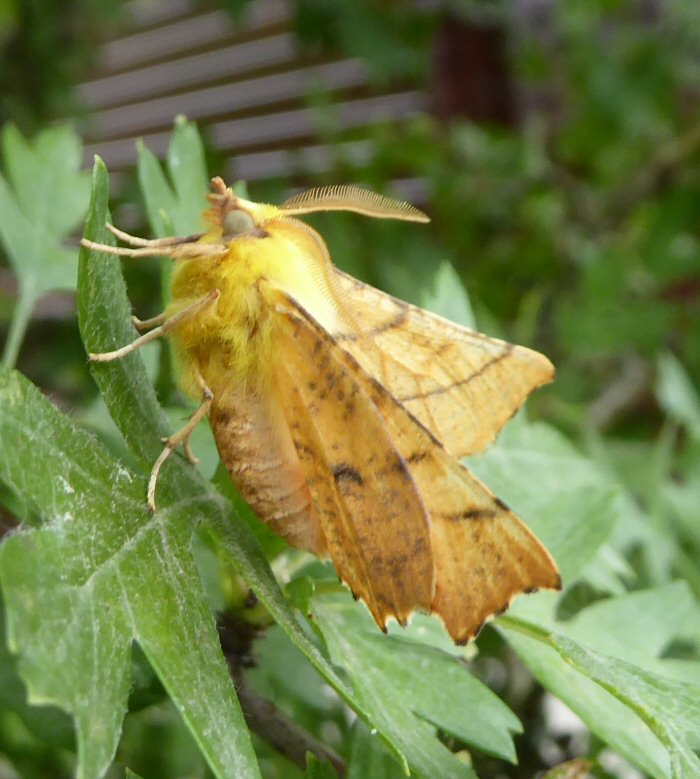
Mother of Pearl lives up to its name, reminding me of the buttons of my childhood.
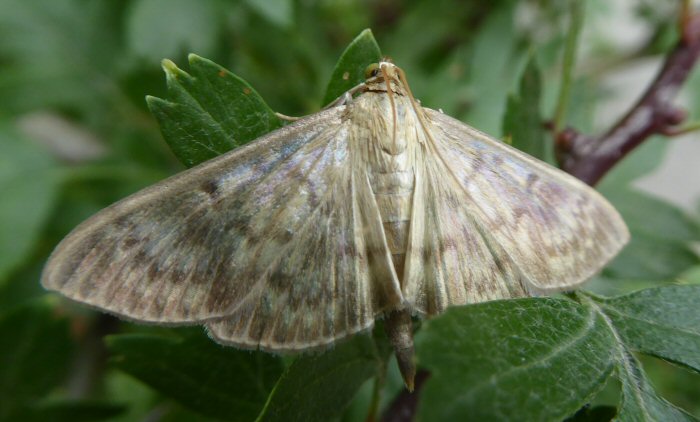
Some of the Chevron moths were newly hatched and their colours were pristine. The colour varies and some moths can be quite yellow. It inhabits moorland and woodland. Food plants of the caterpillar are sallows, Aspen and birch, all of which can be found in Foxglove.
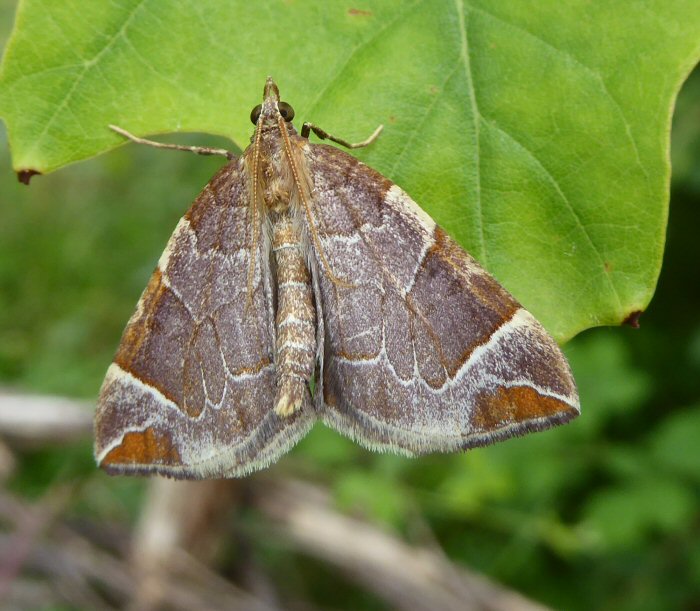
Dark Arches is a large moth. Caterpillars feed on the bases and stems of grasses.
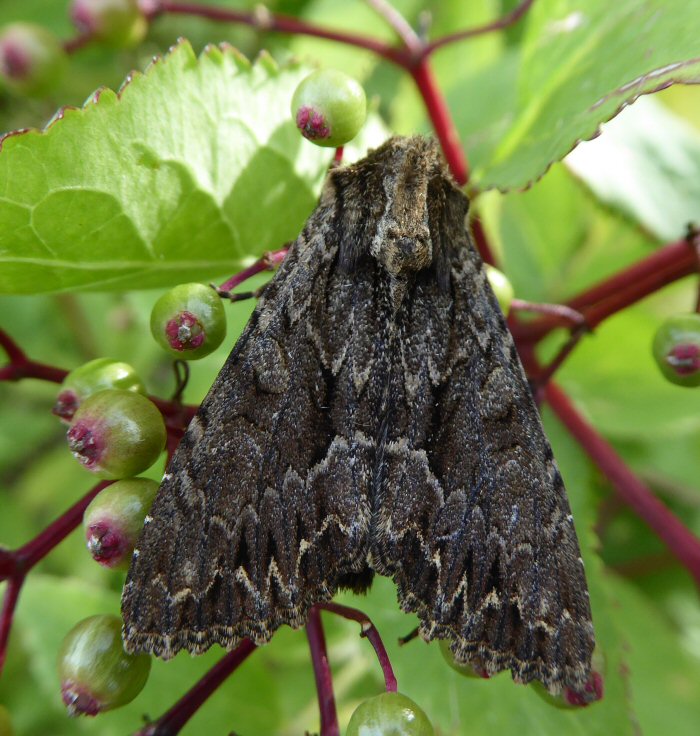
Just off the egg box it proved to be shy. Some careful rearrangement was needed to get the above photo.
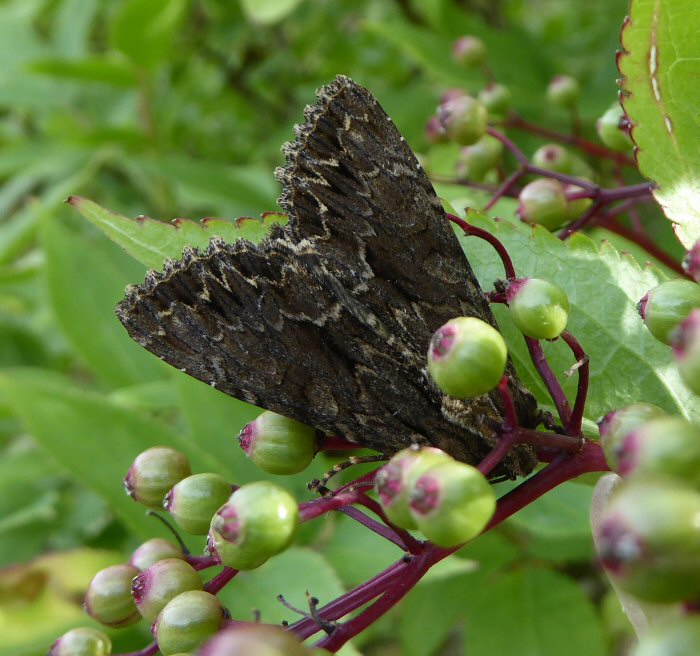
A huge thank you to everyone involved in setting up all the traps, collecting them and all the other equipment that goes with them and returning everything to the Field Centre.
If you would like to see some moths, then the Foxglove trap is put out on a Tuesday evening, unless the weather forecast is bad, and emptied on Wednesday morning with identification taking place in the Field Centre. You will be made most welcome.
Wings!
Friday, August 3rd 2018
Many of us hear the screams of Swifts as they fly overhead searching for insects. Initially they were slow to arrive this year but their numbers have increased more recently. They will soon be heading in the opposite direction on their long journey south once more - their stay in this country is really quite short.
We are all aware of the dangers that plastics pose in our oceans, but they can also be a danger on land. A Swift was seen hanging from a soffit, in a street in Leyburn. The traffic was stopped and a ladder raised to rescue the bird. When it was brought down it was seen to have rubbish, including plastic, wrapped around one of its legs. You can see the material below once it had been very carefully removed. It is likely that this detritus had been in or around the nest because it had been on the leg for some time acting as a tournique. The foot on the affected leg was black and dead but the remainder of the bird was fine although it looked very hungry. The rubbish had prevented it from flying and the bird was entirely dependant on its parents for food.
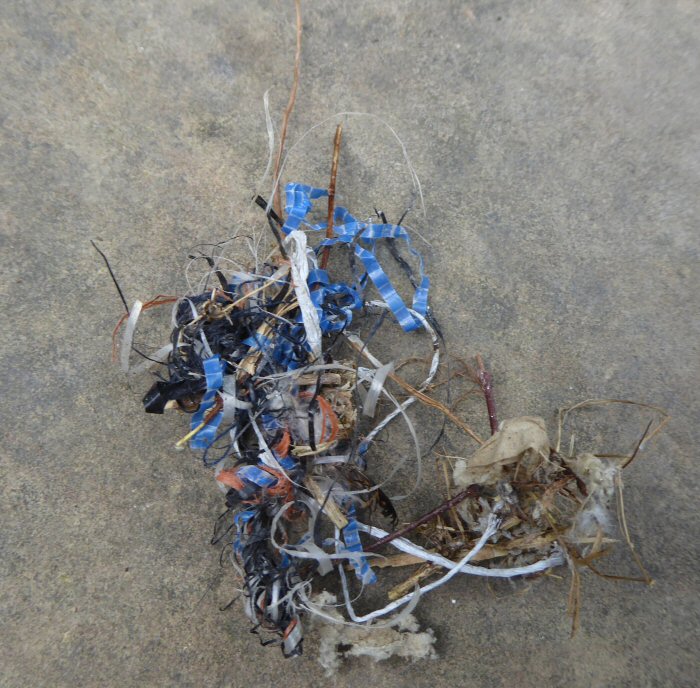
The juvenile Swift was brought to Foxglove where it was measured and ringed. The wing was 171mm long! It was returned to Leyburn and flew away strongly to rejoin the remainder of its family.
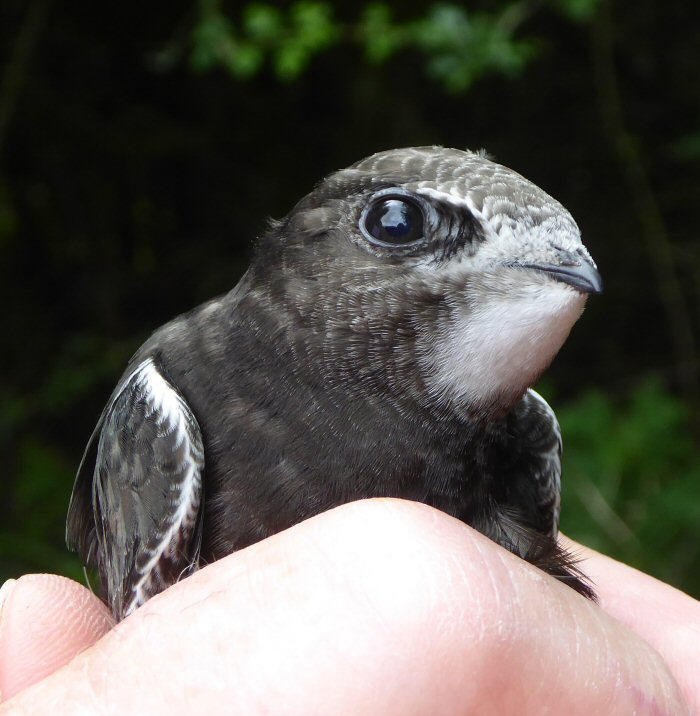
CES 9 had to be rearranged due to the poor weather earlier in the week. When the forecasts had been scrutinised earlier, Friday was the perfect day weatherwise. Unfortunately the forecast changed with rain and possible thunder to arrive early in the afternoon. A careful eye was kept on the billowing clouds but not a drop of rain fell. We were very lucky.
Only five CES 9 days over 26 years have had a better catch than today. In amongst the 245 birds processed were several Chaffinches over four years old. Again most of the birds were juveniles and many were into their post juvenile moult. Some of the male Blackcaps were changing their brown caps, which they have when they fledge, to their adult black one.
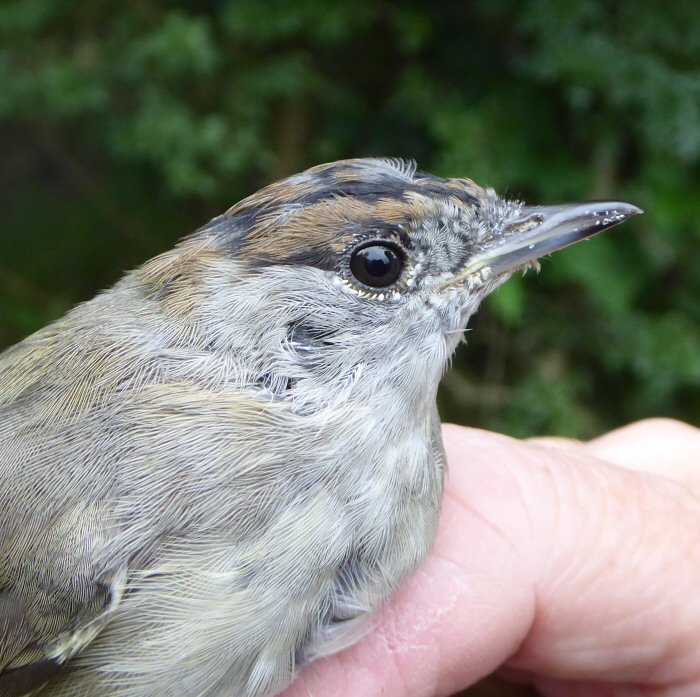
It was a delight to see a young Redstart arrive in the ringing room.
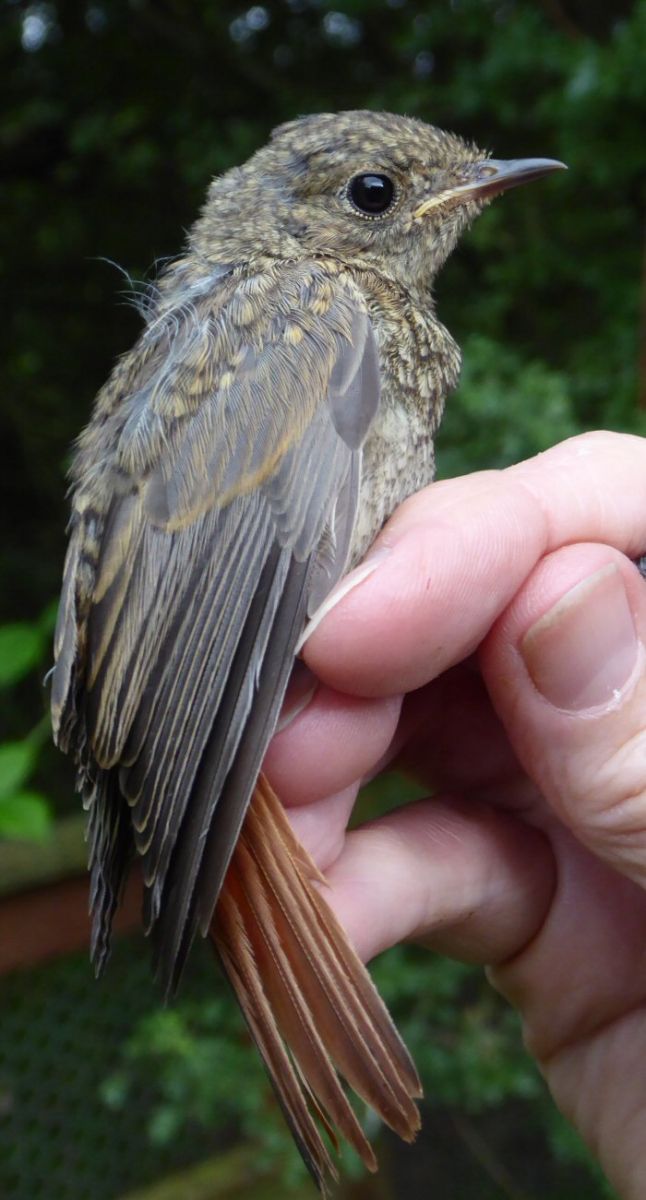
There were other winged creatures around. This huge Robin's Pincushion Gall is the home of the larvae of tiny wasps.
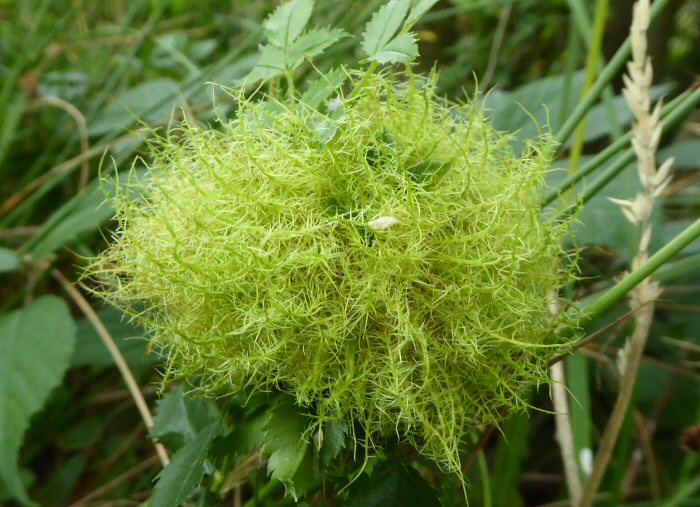
Although dull some butterflies were flying and feeding. A Meadow Brown was enjoying the nectar from Knapweed.
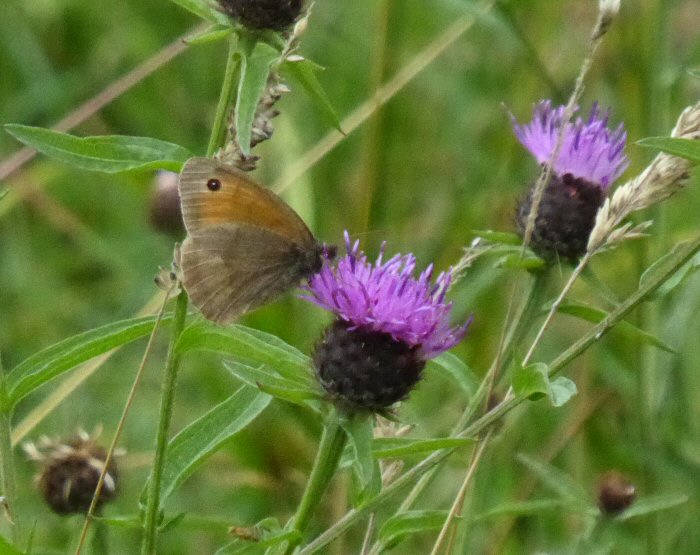
On Wednesday we followed a Painted Lady around the orchard, but it was two steps ahead of us all the time. I thought today was going to be the same but then it landed and with a good bit of zoom on the camera I managed to get a photograph.
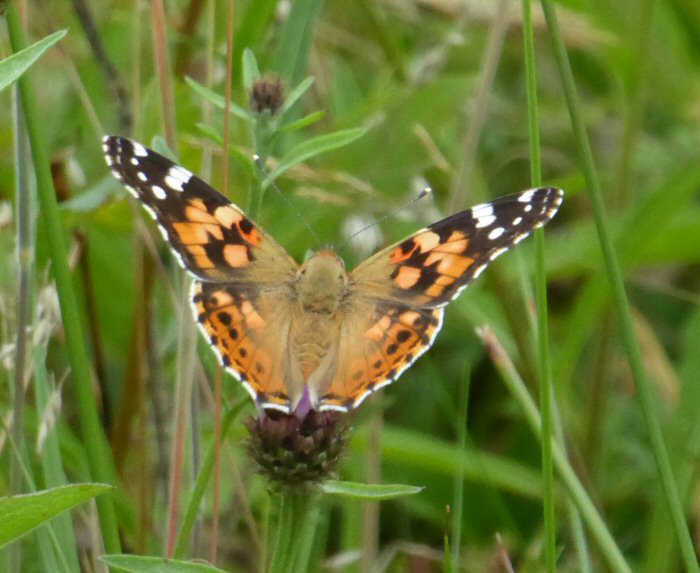
It was a busy day for the bird ringers, with a 0430 start and a 1715 finish. Thank you to everyone who helped. The birds ringed today pushed the total of new birds ringed on the reserve to over 62 thousand!
Reed bed cutting on the Lake
Thursday, August 2nd 2018
Aside from all of the many tidying up jobs that were carried out across the Reserve today we have been tackling the reeds that were starting to obscure the view from the Easy Access Hide by the Lake.

Waders are definately required for this task as going for some of the reeds further from the bank wearing anything else would end in disaster.


Bug Detectives
Thursday, August 2nd 2018
We had a great day of Bug Detective work yesterday with Roger Key; as always enjoyed by all, if not slightly more by some of the more enthusiatic parents!

After a quick briefing on the proper handling of nets, beaters and pots we made it half way to our destination before stopping to look at some interesting captures (as is often the way).

Once we had arrived it was time to fan out and get catching!

We're still waiting on identification of some of the specimens found yesterday, however I was having plenty of fun helping people where I could and taking pictures.
As always Knapweed proved very popular with pollinator species, including this male Buff/White-tailed Bumblebee (notice the elongated antenna), and this female Marmalade Hoverfly (Episyrphus balteatus) with each of its abdominal segments possessing two dark bands seperated by two orange bands, which is distinctive in British hoverfly species.
This incredible little hoverfly is ubiquitous and can even be seen on sunny days in the middle of Winter! Often mass immigrations of this species in the summer months lead to reports of 'plagues of wasps' by the uninformed press.

We also happened upon a number of amphibians throughout the day, finding many frogs and even this juvenile Smooth Newt.

I also happened upon this White-clubbed Hoverfly (more commonly known by its latin name Scaeva pyrastri), another distinctive hoverfly species as it possesses three pairs of white lunules (comma markings) on the abdomen. If this were Scaeva selenitica then these marking would taper towards the periphery and would be more yellow in colour.

Another great pest controlling species, the larvae feed on different aphid species, consuming anywhere up to 500 aphids during their larval stages. Numbers vary dramatically year on year, as like the Red Admiral or Clouded Yellow butterflies it is a migratory species that can and often will breed locally at lower elevations.

As a side note Scaeva pyrastri - and it is not on the online species list and so is likely to be a new species to the Reserve!
Keep an eye out for future blog posts on more of the as yet unknown species caught yesterday by our Bug Detectives; Roger believes we may yet have a couple more new species to add to the list.

.JPG)
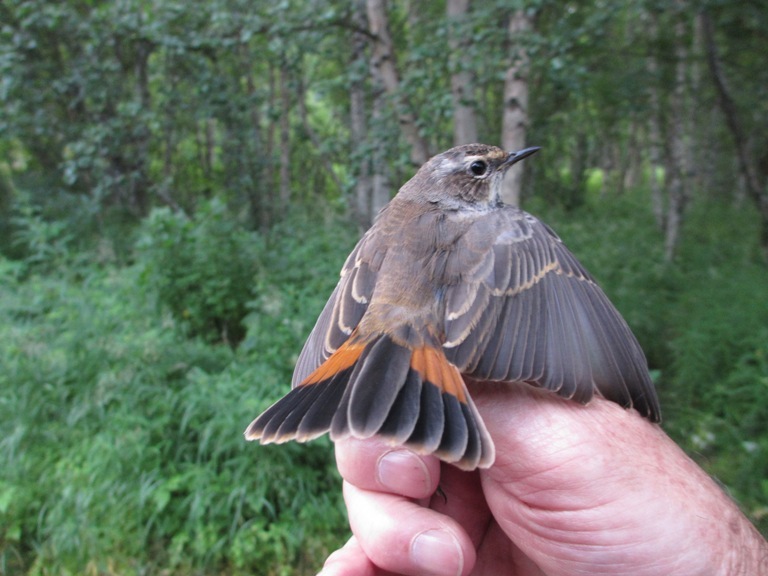



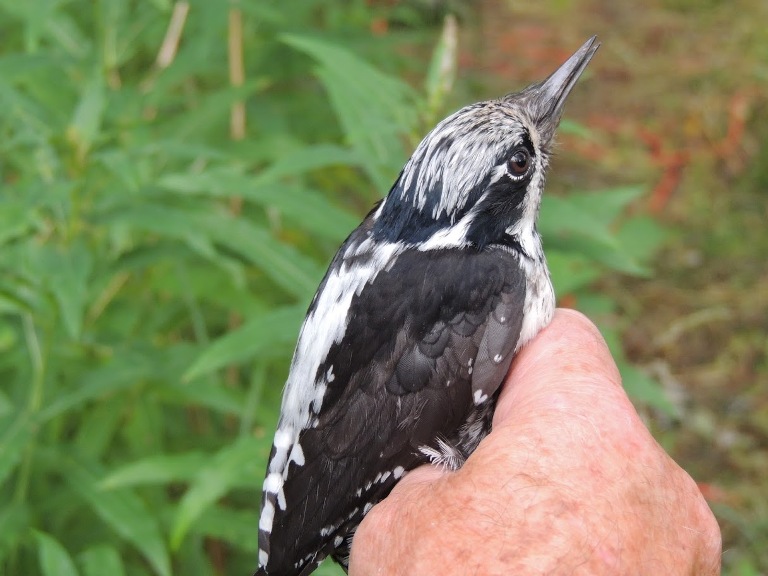
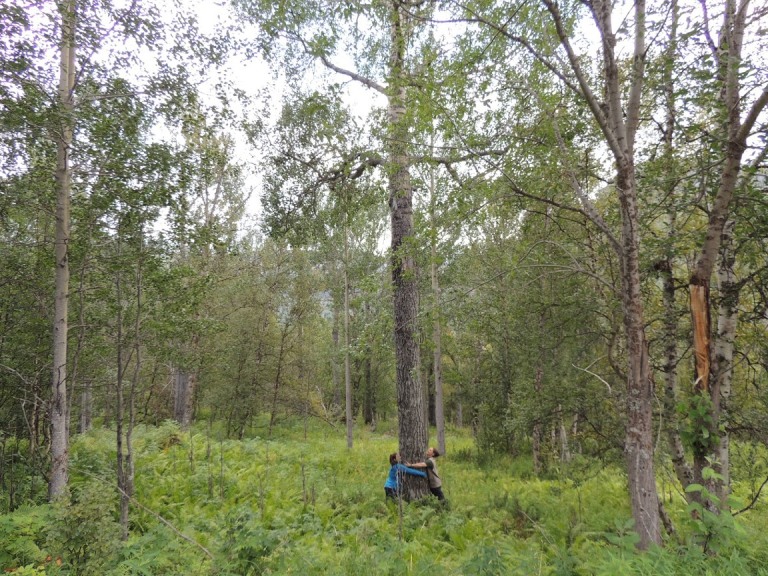




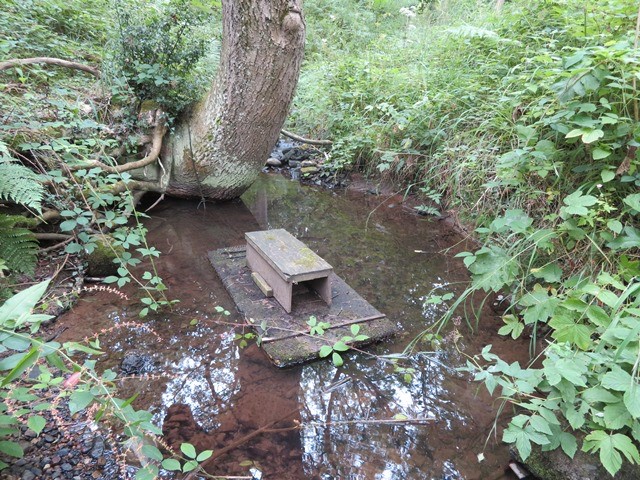






.JPG)


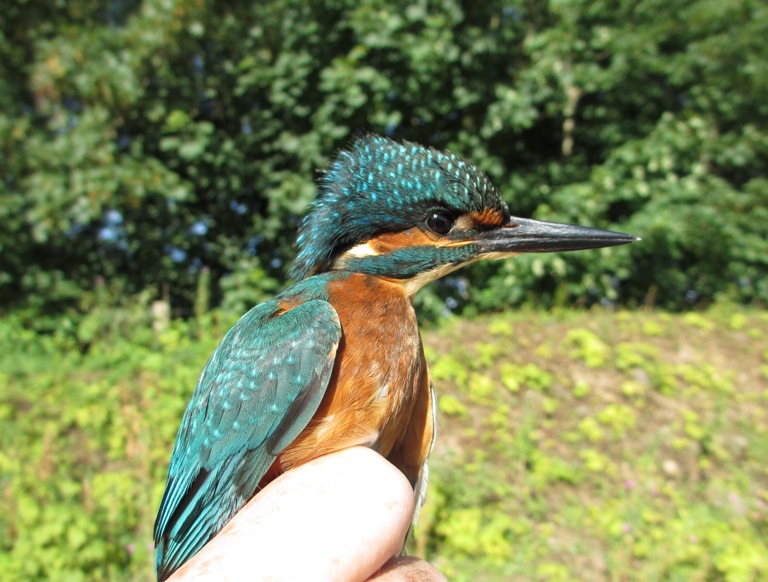
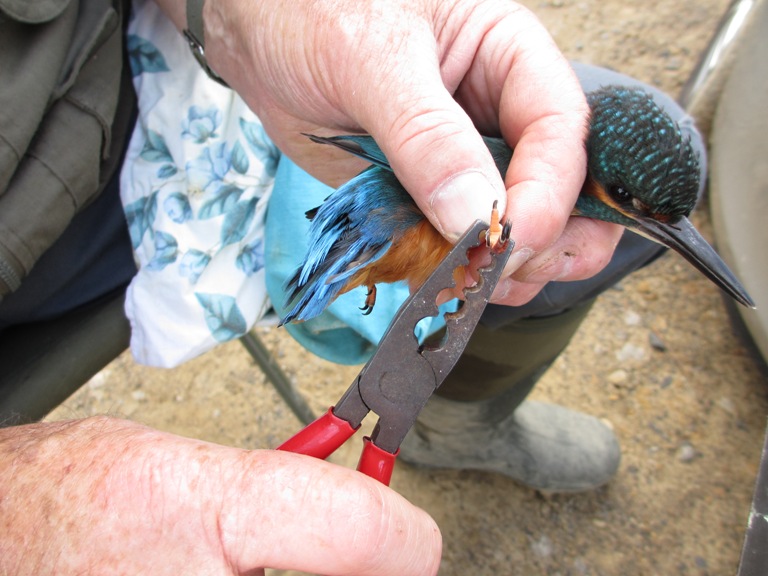

.JPG)
